Memory conflicts on social media: a Twitter data analysis
Third report (2020) by Celeste Muñoz Martínez
Data collection by Mariluz Congosto
Preliminary considerations
This third report, which corresponds to the first half of 2020, continues with the tracking analysis of the signification and resignification of Europe’s past in social media, specifically on Twitter. However, the report also includes significant new perspectives on the work, because the continuation of the project has made it possible to begin making some anticipated comparisons among commemorations, identifying changes and continuities in relation to the previous year’s data. As a result, the interpretations that are inferred in the present study have greater analytical depth, thanks to expanded sampling capability.
At the wider European level, the prominent commemorative dates captured in the report are Holocaust Remembrance Day (27 January) and Europe Day (9 May). As noted in the previous report, the two dates in question are stable, annual events, so the monitoring of their evolution is easier than tracking one-off events like centenaries or other anniversaries. Also, at the specifically Spanish level, data were again collected on the commemoration of the Second Spanish Republic (14 April). It is necessary once again to recall that the anniversary of the proclamation of the Second Spanish Republic is not recognised by the Spanish state as an official holiday. However, the anniversary has remained deeply rooted in popular memory for generations, making the event an example of informal remembrance kept alive by popular initiative without any planning support from the state executive (though sometimes with backing at the municipal level or from some political parties).
These preliminary considerations also need to note the adverse context affecting Europe and other continents in the months of April and May 2020, which must be taken into account in the analysis of any commemorations that took place in the period. The Covid-19 pandemic and the resulting widespread quarantine of populations have been unprecedented in scale in the past century, and they have diverted – and focused – a great many of the debates. On the other hand, preliminary studies also suggest that the pandemic and quarantine may have given an impetus to the use of the internet and social media as sources of information and communication.[1] However, the pandemic and the need for social distancing have also led to an upturn in digitisation and serious rethinking of the so-called digital divide or digital gap as an indicator of social exclusion and integration.[2] Despite the apparent trend, however, it is too soon to draw any conclusive results about the specific impact.
Table 1. Overview of dates for comparative sampling
| 2019 | Sampling dates | 2020 | Sampling dates |
| Holocaust Remembrance Day | 25-30 January | Holocaust Remembrance Day | 25-30 January |
|
Europe Day |
6-13 May
|
Europe Day |
8-14 May |
| Commemoration of the Second Spanish Republic | 12-17 April | Commemoration of the Second Spanish Republic | 12-29 April |
Methodology
First, the procedure for sampling and processing data extracted from the internet was conducted by Dr. Mariluz Congosto, a professional and assistant professor in the Department of Telematics Engineering at Carlos III University in Madrid.[3] Next, the interpretative analysis of the technical files resulting from Dr. Congosto’s work was carried out by Dr. Celeste Muñoz Martínez, a lecturer in the Department of History at the University of Barcelona, who was also responsible for the second report in 2019.[4] In this respect, the project team places particular importance on the continuity of the individuals who have produced the findings of the Online Memories project. Continuity permits greater discursive consistency and facilitates the ongoing introduction of methodological adjustments. Joint effort and bilateral expertise are fundamental in the development of research in emerging fields, which by their nature lack fixed methodologies that could be applied in areas like memory and history. As a result, it is the team’s view that the creation of a tangible methodological framework is one of the leading contributions of the project, which seeks to give an impetus to the interdisciplinarity that is needed between the social sciences and applied computing.
Specifically, between the second and third reports, no substantial changes have been introduced in the data extraction procedures. The team continues to identify trending topics and key words (without a hashtag) that are associated with a particular commemoration by making use of the portal Trendinalia.[5] As noted in earlier reports, searches of this type are generally limited to the linguistic field, not the geographical field. For this reason, the aim throughout the project has been to gradually expand the language options used in the tracking. This approach has led to a gradual increase in the identification of new communities by language use and the inclusion of voices from Eastern Europe, which were absent from the earlier data files. Similarly, the introduction of time bands has made it possible to narrow down more precisely the (nevertheless always estimated) geographical origins of tweets, given the different hours of use in Europe and the Americas. The time bands prove particularly useful in identifying the origin of information generated in Spanish and English according to time band. At a more technical level, it has also been possible to configure the graphs and figures that form the basis of the study by combining the methods of web scraping and T-hoarder (streaming API). In addition to the above considerations, it is important to add, as mentioned earlier, that the team took a decision in the second half of 2019 to increase the qualitative markers over and above the quantitative ones. As a result, the current half-year has witnessed a sharp increase in the collection of the most significant tweets for each of the identified trending topics. Unfortunately, comparative analysis of this variable is limited, because the indicators had not yet been incorporated in detail back in the first half of 2019.[6]
Lastly, it is still fundamentally important in the team’s view to continue improving the sociological and technological profiles of users in order to obtain a better collective profile of the population segment that uses Twitter, generates content and ultimately produces opinions that can sometimes even go viral and have an impact on public opinion. In this respect, we must take into account the growing presence of legislation on hate crimes and more recently on so-called fake news.[7] Such laws seek to act as a filter against harmful content that can gain prominence over time, given the capacity and permeability of social media when generating political and social debate. However, these laws are sometimes denounced by a range of activists on the grounds that they constitute censorship, since the determination of hate crimes and fake news often requires an interpretation that is open to question.[8] Putting this clash aside, however, social media and their control are increasingly at the centre of political and legal debate. One example of the growing institutional concern is evident in Article 37 of the EU resolution “On the situation of fundamental rights in the EU”, prepared by the European Commission, in which the European Parliament states that: “[It] is concerned about the alarming increase in manifestations of hatred, hate speech and fake news; condemns incidents of hate crime and hate speech motivated by racism, xenophobia or religious intolerance or by bias against a person’s disability, sexual orientation or gender identity, which occur in the EU on a daily basis; stresses that tolerance for the propagation of the rhetoric of hatred and fake news feeds populism and extremism; believes that systematic civil or criminal law measures can halt this harmful trend”.[9] To better understand the context, the EU launched a project in 2015 under the name Prism (which stands for preventing, redressing & inhibiting hate speech in new media). The Prism project set out to examine state legislation on hate crimes and produce an inventory of best practices for online platforms (e.g. Microsoft, Twitter, Facebook, etc.).[10] In spite of the project’s efforts, however, hate crimes have continued to grow on a yearly basis (see Figure 1 below) because of inaction or inability to monitor billions of data generated by millions of users, who are very often anonymous or even bots.[11] In any event, there is clearly a battle over the spaces in question. Some social media are harnessed to spread racist, homophobic and sexist ideas that fuel so-called hate speech, while others offer a space that enables users to bypass a certain degree of censorship of information or a hegemonic press and to enhance their access to information, despite their low ability to spot fake news. For still others, social media provide an ideal place to engage in politics, generate opinions and win elections. At this intersection, symbols like commemorations also serve as a tool to spark conflict, which draws in an increasingly greater number of participants and feeds on itself.
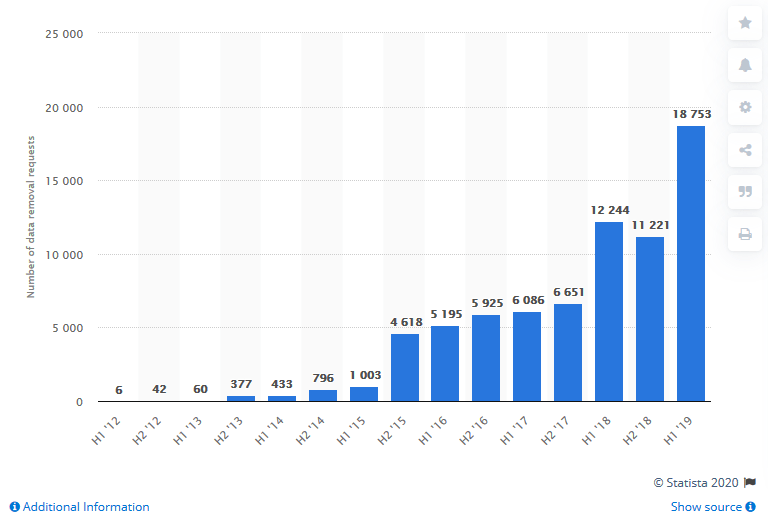
Figure 1. Number of data removal requests issued to Twitter from 1st half 2012 to 1st half 2019.[12]

Figure 2. Legal demands worldwide about Twitter (taken from Twitter’s transparency report).
The sociological and technological profile
In 2020, Twitter data indicate that the platform has approximately 330 million active accounts that generate, on average, 500 million tweets a day, 80% of which are posted from a smartphone.[13] At one level of analysis, activity has increased by 24% over the previous year. Twitter attributes the increased growth to improvements in service and, especially, to digitisation caused by the pandemic.[14] In this vein, we can confirm that Twitter is growing in prominence and followers even though it does not enjoy as much popularity as other platforms (see Figure 3 below). However, the high concentration of politicians and celebrities posting opinions on current events have turned Twitter into a strategic network on the political and institutional agenda of countries (see Figure 4 below). In the United States, the Twitter profile with the most followers at present belongs to former president Barack Obama (111,470,000 million followers), while in the United Kingdom, it belongs to the BBC news channel (43,999,589 million followers). In France, the daily Le Monde ranks third (8,860,044 million followers), while in Italy, profiles like those of Pope Francis (4,973,454 million followers) and former premier Matteo Renzi (3,397,227 million followers) stand in fourth and eighth positions, respectively.[15]
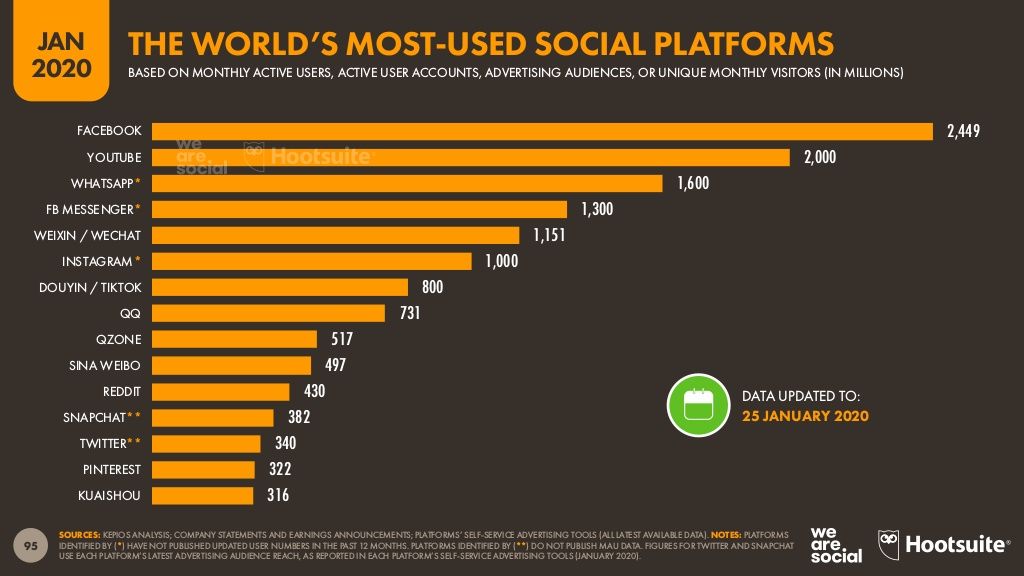
Figure 3. The world’s most used online platforms. Source: Hootsuite
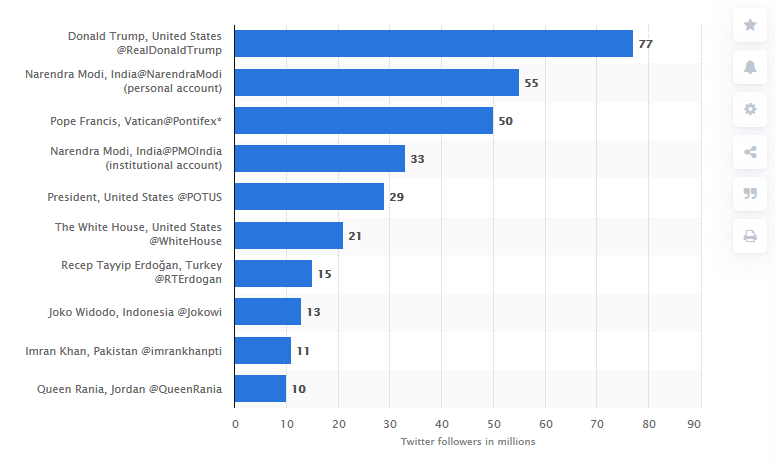
Figure 4. World leaders with the most Twitter followers as of April 2020.
Indeed, Twitter is the top platform in terms of current events and news content, which accounts for 53% of its activity (see Figure 5 below). As a specific example, up to 48% of Europeans in 2019 said that their interest in Twitter was to do searches and make comparisons of news items, that is, to treat Twitter as a news outlet.[16] Since its early days, Twitter has clearly become established as an information platform of collective construction with – for better or worse – limited filter controls, as well as the leading space for online politicisation over and above other platforms.
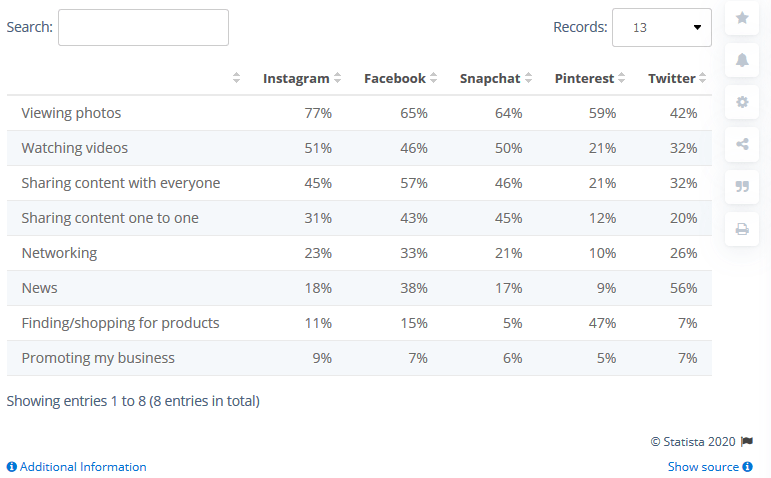
Figure 5. Social media activities on select social media platforms.
Apart from the above considerations, the sociological profile of Twitter users remains quite similar to the profile described in the previous report. Women are still a minority on the platform, accounting for only 34% of users compared to men, who account for 66%. While the data are not broken down by country, Hootsuite has found that the highest rates of feminisation in 2020 occur in Asia and the highest rates of masculinisation occur in Africa. The continents of Asia and Africa have relatively few users in comparison to Europe and the Americas, but they have a potential for year-on-year growth. In addition, 80% of all platform users are younger than 50 years of age and there is, in general terms, a clear preference for use among young people and middle-aged people (see Figure 6 below). Similarly, at the socio-economic level, most users have an above-average income in relation to the population in their environment, although the data refer only to the United States and it is therefore necessary to exercise caution when venturing generalisations. In the same vein, Twitter appears to feature a prevalence of users with higher education, although once again the data are limited to the United States and hard to replicate in other contexts.[17]
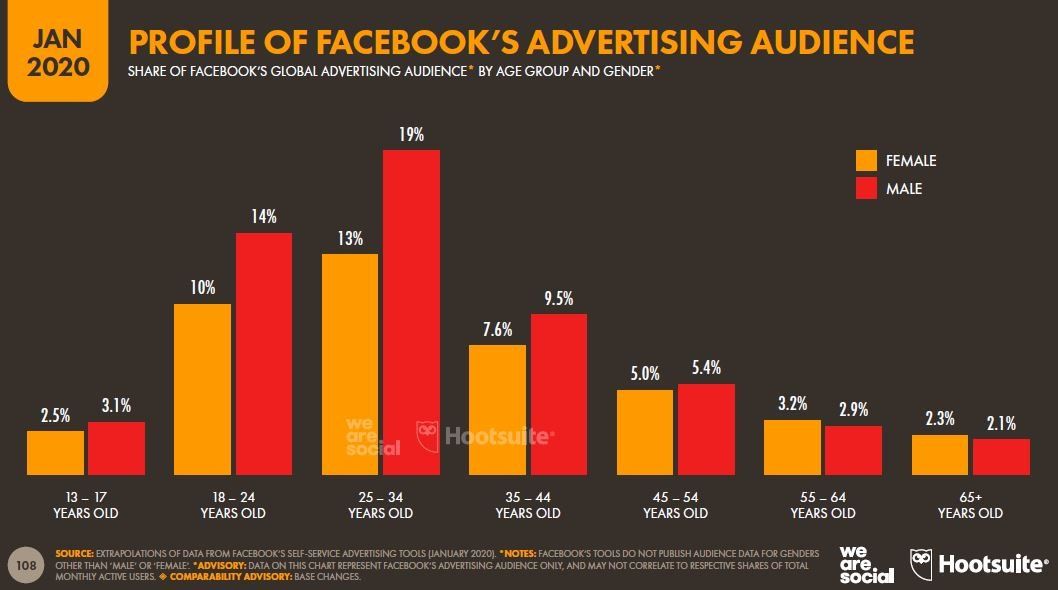
Figure 6. Distribution of Twitter profiles by age group and gender (2020).
In terms of usage by geography, the largest share of Twitter users are still in the United States. However, the platform continues to grow worldwide and in geographical diversity. European users represent 22% of the total and Twitter is more popular in Western Europe than in Eastern Europe. However, there has been some increase as a consequence of Twitter’s general growth. For instance, UK user numbers have risen from 13.6 million to 16.7 million, while the total in Spain has climbed from 6.1 million to 7.5 million users, France is up from 5.5 million to 7.4 million users, and Germany has seen a rise from 3.8 million to 5.2 million users (see Figure 7 below). However, it is important to bear in mind that these figures are absolute numbers. By contrast, if we look at demographic reach, the European countries with the greatest Twitter reach are the UK (29%), Sweden (22%), Spain (18%), Switzerland (14%), Portugal (14%), France (13%), Belgium (13%), the Netherlands (12%), Austria (11%), Germany (7%), Italy (6%), Poland (4%) and Rumania (2%), according to Hootsuite’s report for 2020.
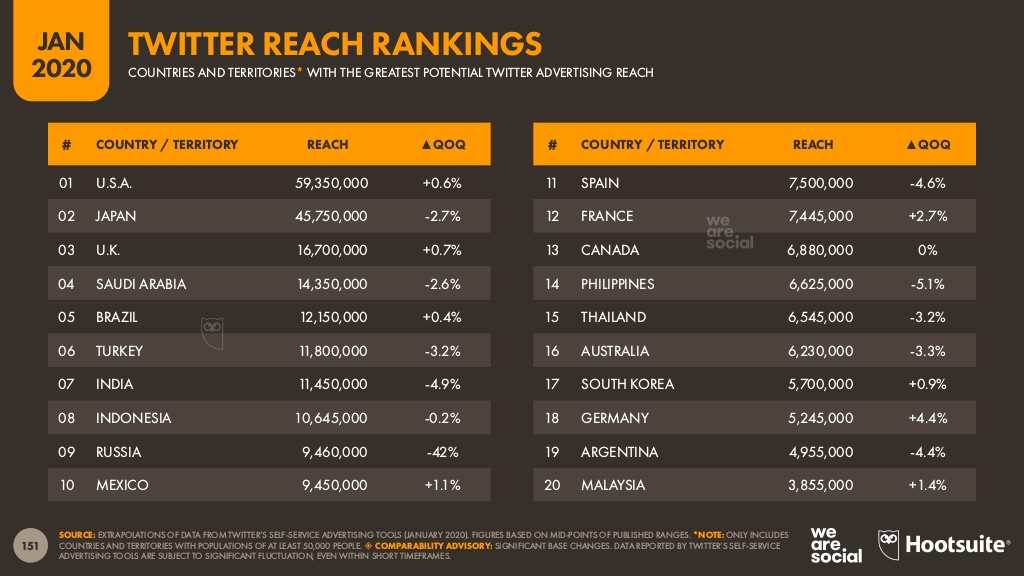
Figure 7. Twitter reach by country.
Individual comparative readings
International day of commemoration in memory of the victims of the Holocaust
In 2005, the UN General Assembly and the European Parliament established 27 January, the anniversary of the date on which the Soviet Red Army liberated Auschwitz in 1945, as an international day of commemoration in memory of the victims of the Holocaust. As a result, the Holocaust remembrance day is freighted with symbolic and political meaning and the seventy-fifth anniversary in 2020 had enormous media impact because of the size of the ceremonies and the accompanying controversies. This can be observed in the quantitative comparison. In 2019, the analysis found and sampled a total of 26,954 tweets (which rose to 123,776 through retweets), collected between 25 and 30 January. By contrast, the volume in 2020 came to 453,154 (rising to 2,615,474 through retweets). That is, the event was massively followed by up to 982,914 profiles interacting through tweets and retweets. Because the size and scale of the response exceeded the limits of the Gephi network analysis tool, it was necessary to prune the graph. To do so, a selection was made of the 500,000 profiles that were most active or had the greatest impact. The pruning does not change the structure of the graph, but it does obviously change the size of the various communities.

Chart 1. Network of spread by community for Holocaust Remembrance Day.
After pruning the data in the resulting chart of affinity groups, four main communities stood out in terms of the percentage of their members: US Democrats (13.6%), the Auschwitz Museum (12.33%), the Spanish left and Catalan pro-independence group (10.77%), and the pro-Donald Trump community (10.73%). Based on this identification, it can also be observed that the US Democrats are closer to the UK left than to the pro-Trump group (see Chart 1 above). However, when identifying communities in terms of ideology, it is necessary to bear in mind that Twitter is a global tool. In other words, spread is local and language acts as a barrier. As a result, three factors affected the formation of communities in the above case: territory, language and ideology. Specifically, the structure of the network in Chart 1 shows three language blocs: English predominates in the top part, international organisations appear in the middle, and Spanish, French and Portuguese are dominant in the bottom part. As noted earlier, however, ideological affinities shape the final distribution. Therefore, for the tweets from the US, UK and Spain, there is a separation of communities by ideology, which can be observed by comparing Chart 1 above and Chart 2 below. In short, language is a barrier that compounds separation by ideological affinity in the relationships between communities.

Chart 2. Distribution by language group.[18]
In terms of the mechanisms of content spread, it is striking that only 38.83% of the posted messages included hashtags. The hashtags appeared in a number of specific areas, but primarily in the Auschwitz Museum community. The most popular hashtags were: #Auschwitz (6.77%), #HolocaustMemorialDay (6.4%), #WeRemember (2.86%), #HolocaustRemembranceDay (2.41%), #Auschwitz75 (2.32), #Holocausto (1.26%), #NeverAgain (1.17%) (see Chart 3 below). To understand the data, it is important to recall that the use of hashtags generally corresponds either to organised campaigns aimed at raising the visibility of a subject or to users wanting their tweet to be read when people search for a hashtag. As we can see, however, most of the content was not linked to such campaigns, given the heterogeneity and spontaneity of the 61.17% of tweets that had no hashtag and that have been sampled by means of key words. In 2019, the phenomenon of tweets without a hashtag accounted for only 36.89% of all content related to the commemoration.
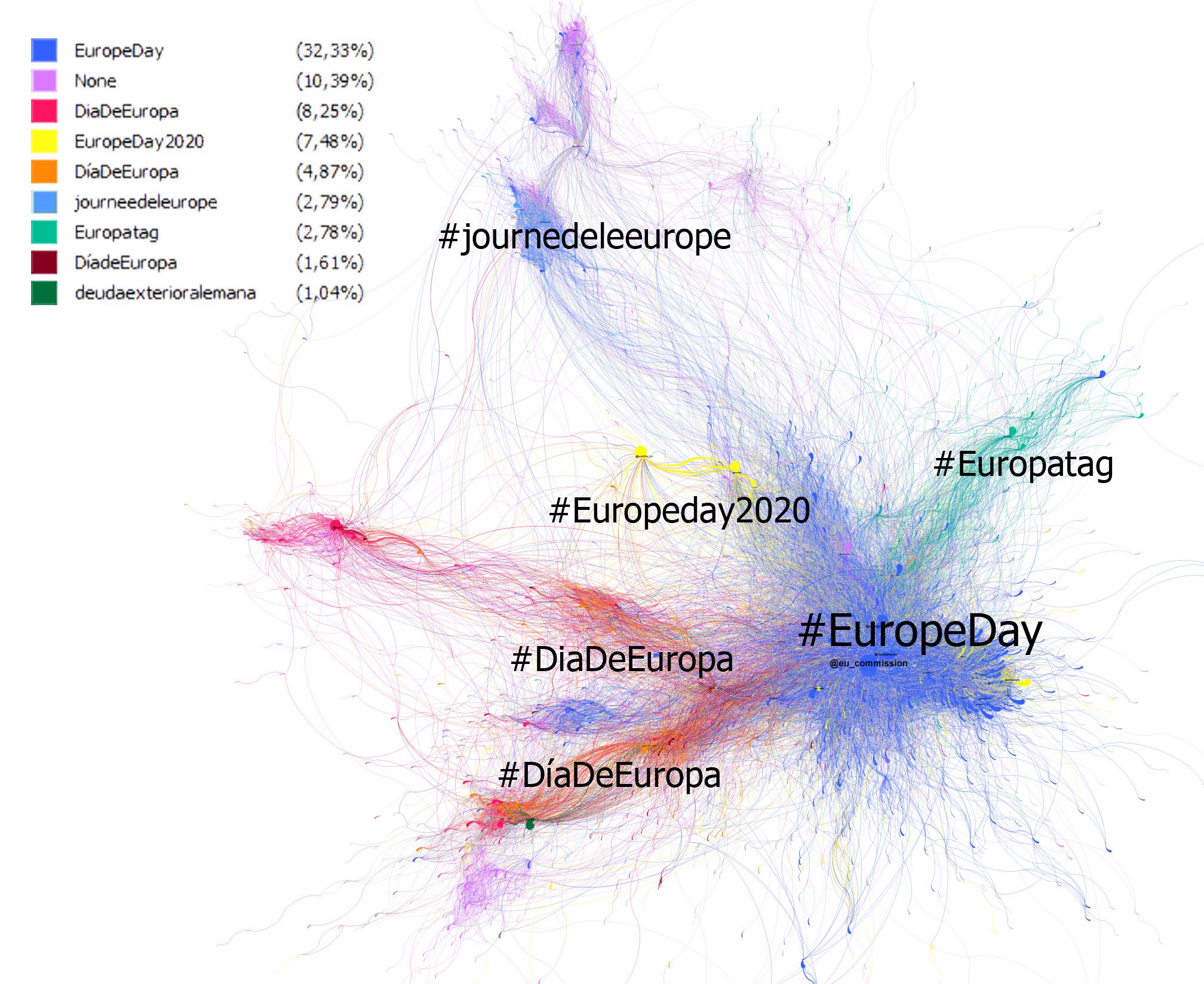
Chart 3. Distribution by hashtag.
In terms of dates and times, the heaviest activity took place on 27 January, while activity fell slowly on the days that followed. Specifically, the peak time was 4 pm (GMT) when 16,439 tweets were posted and received 113,832 retweets. This was a time at which the working hours in Europe and the Americas overlapped. It is important to bear in mind that the commemoration is widely followed on both sides of the Atlantic.
As for content, we have an enormous amount of information on the narratives used by the different communities. Unfortunately, comparison is very limited due to the absence of data on the dimension from the same period of the previous year. However, such comparisons will be possible in the second half of 2020.
Before moving on, it must be noted that the enormous amount of content logically makes it difficult to give an exhaustive interpretation. As a result, it will be necessary to rank content in terms of reach. To do so systematically, we have firstly separated the main content of the following communities: US Democrats, Auschwitz Museum, Spanish left, pro-Trump groups, the UK left, Spanish and English right-wing groups, the Brazilian right, and international organisations. However, to produce a smoother analysis, we have secondly separated the content into three overarching blocs: the left (appearing on the left in the chart), the right (appearing on the right) and institutional tweets (appearing in the middle).
Among the left, it is generally necessary to situate the political confrontation or use of the commemoration in terms of present-day conflicts. In doing so, the US Democrats can be seen to use the date as a way to criticise US President Trump’s politics of hate through veiled or explicit comparisons. For example, the most popular tweet among the US Democrats was posted by the journalist Rabbi Danya Ruttenberg (@TheRaDR), who issued an appeal for unity against hate in the present (see image below). Another popular tweet came from US Senator Bernie Sanders (@BernieSanders: “On this day 75 years ago, Allied forces liberated the Auschwitz-Birkenau death camp, the scene of the most horrific mass atrocity and genocide in history. Today we must remember the lessons of those dark days and acknowledge the danger of letting hate and anti-Semitism fester”). In addition, tweeter Joshua Potash, who does not belong to any political party but whose tweets circulate within the community of US Democrats, seized on the opportunity to make a similar point (@JoshuaPotash: “Trump is marching us toward fascism. But don’t take it from me. Here is Holocaust survivor Bernard Marks confronting ICE director Thomas Homan – comparing ICE raids to Nazis [sic] raids. The time to fight like lives depend on it is right now. Because they do”). On the Spanish left, the date was utilised to pay tribute both to Spanish Republicans murdered in concentration camps and to combatants against fascism, since despite Spain’s declared neutrality in the Second World War, Spanish participation in the resistance was prominent. Among the most popular tweets was one from the Second Deputy Prime Minister of Spain Pablo Iglesias (@PabloIglesias: “Se cumplen 75 años desde que las tropas soviéticas liberaron Auschwitz. Allí fueron asesinadas decenas de miles de personas, entre ellas, cientos de republicanos españoles a los que marcaban con un triángulo rojo invertido. Memoria para no repetir la Historia. Fascismo nunca más” [“Today marks 75 years since Soviet troops liberated Auschwitz, where tens of thousands of people were murdered, among them hundreds of Spanish Republicans who were forced to wear an inverted red triangle. Memory in order not to repeat History. Fascism never again”]). However, prominence was also given to the importance of the Soviet Union’s role, which is often left out of the commemorations even though the Red Army’s troops were the liberators of Auschwitz. For instance, one of the most popular tweets came from Javier Lezaola (@JavierLezaola: “¿Lo de que 75 años después mucha gente siga sin saber que el campo de concentración nazi de Auschwitz lo liberó el Ejército Rojo de la URSS de Stalin a qué se debe, a los más de 30 años de franquismo o a los más de 40 de “democracia”?” [“The fact that 75 years on so many people still do not know that the Nazi concentration camp of Auschwitz was liberated by Stalin’s Soviet Red Army – is it because of 30 years of Francoism or over 40 years of ‘democracy’?”]). Also prominent for its impact and reach within the community was a tweet from Nicolas Maduro, president of Venezuela, who seized on the opportunity to stress the importance of the Bolivarian Revolution (see image below). Among the UK left, the narrative was quite homogeneous and limited to a remembrance of the events without much explicit political content. One prominent tweet came from Jeremy Corbyn, then leader of the Labour Party (see images below).

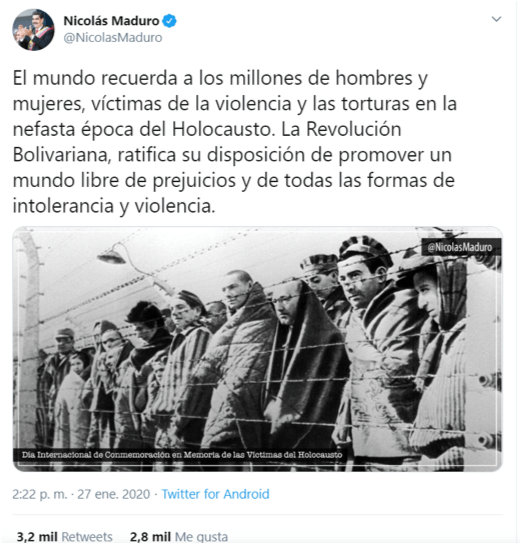
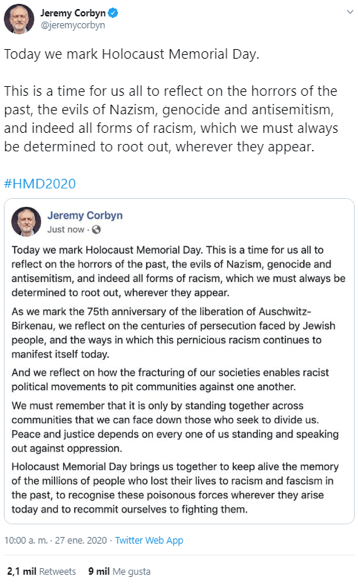
Broadly, the discursive lines of the left focused on commemoration and on rejection of the politics of hate (also in the present, in an explicit political use). Also prominent, however, was an aspect of historical resignification through debates over the key role played by the USSR.
Turning now to the right-wing community, it is necessary to start with the pro-Trump groups, because they represent one of the broadest communities that have a capacity to generate viral content. Oddly enough, the most popular tweet was posted on 30 January in reference to the war in Ukraine. While the tweet’s content did not relate strictly to the Holocaust, it did draw an analogy to the Shoah while featuring a photo of CIA analyst Eric Ciaramella with US president Barack Obama. The tweet was spread widely among US Republican profiles over the sampled dates for the purpose of attacking US Democrats and their foreign policy in past legislatures (see image below). The other most popular tweets were posted by Donald Trump, Ivanka Trump and Melania Trump, which were limited solely to the commemorative nature of the date and featured photos of the liberation of the camps or photos of memorials. Noteworthy among the right was the use by Colombian conservatives, who took advantage of the commemoration to denounce the “genocide” committed by FARC and guerrilla forces in the country. Prominent was a tweet from the Rosa Blanca Association (@CorpoRosaBlanca: “Mientras el mundo recuerda hoy los campos de concentración de Auschwitz, olvida que en Colomba [sic] las Farc hizo lo mismo durante años. Mientras los nazis pagaron con cadena perpetua y pena de muerte el genocidio, en Colombia los criminales están en el Congreso luciendo su impunidad” [“While the world today recalls the concentration camps of Auschwitz, it forgets that FARC in Colombia did the same thing for years. While the Nazis paid for genocide with life imprisonment and death sentences, the criminals in Colombia are in Congress flaunting their impunity”]) (see image below). Another tweet along the same lines came from the political scientist Juan Carlos Pinzón Bueno (@PinzonBueno: “Como olvidar crímenes de lesa humanidad que cometieron nazis contra el pueblo judío, católicos, gitanos, y otras personas en campo de concentración de Auschwitz-Birkeneau. En Colombia Farc cometieron crímenes de lesa humanidad en campo de concentración en El Borugo, La Macarena” [“How could we forget the crimes against humanity committed by the Nazis against the Jewish people, Catholics, Roma and others in the concentration camp of Auschwitz-Birkeneau. In Colombia, FARC committed crimes against humanity in the concentration camp of El Borugo, La Macarena”]). Among the UK right, the most popular tweet was posted by Prime Minister Boris Johnson, who limited his remarks, like most of the community in question, to remembrance of the Holocaust. However, another tweet that had quite a wide distribution among the UK right came from Conservative Party member Benedict Rogers, who used an analogy to the ban on Nazi industries to call for a boycott of the Chinese tech company Huawei (see image below).
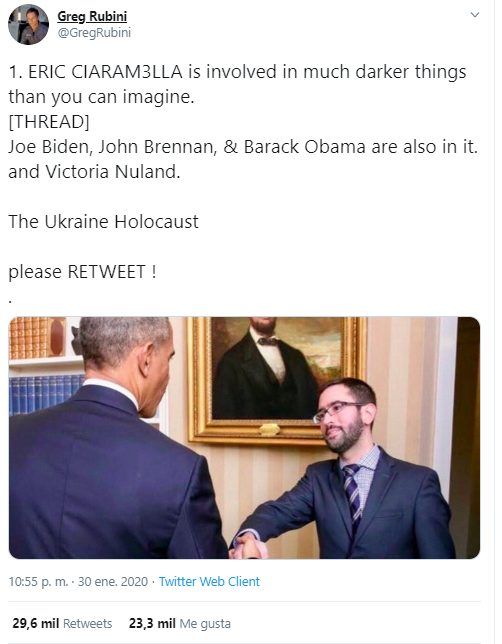
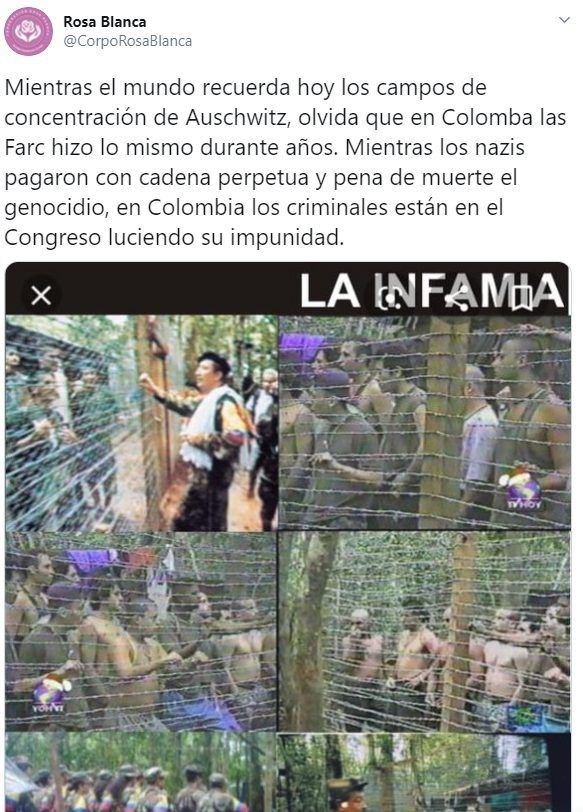
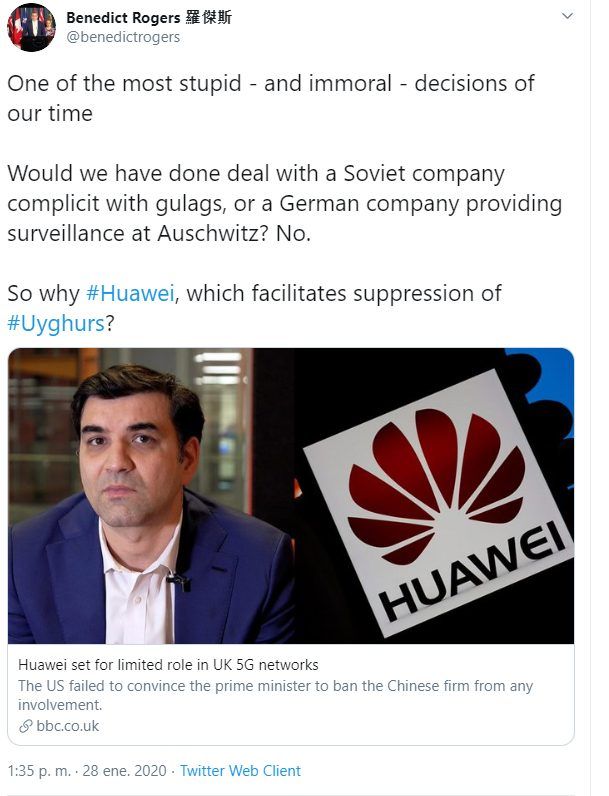
Lastly, institutional tweets also achieved wide distribution and prominence. Especially popular were the tweets posted by the Auschwitz Museum (see images below), which was the source of most of the tweets reflecting the official line. Also prominent were tweets posted by the Vatican account and Pope Francis (@Pontifex_es: “Si perdemos la memoria, aniquilamos el futuro. Que el aniversario del Holocausto, la indecible crueldad que la humanidad descubrió hace 75 años, sea una llamada a detenernos, a guardar silencio y recordar. Lo necesitamos, para no volvernos indiferentes. #JornadadelaMemoria” [“If we lose our memory, we destroy our future. May the anniversary of the Holocaust, the unspeakable cruelty that humanity learned of 75 years ago, serve as a summons to pause, to be still and to remember. We need to do this, lest we become indifferent”]). Other active institutional profiles were UNESCO, the UN and media outlets like the BBC.
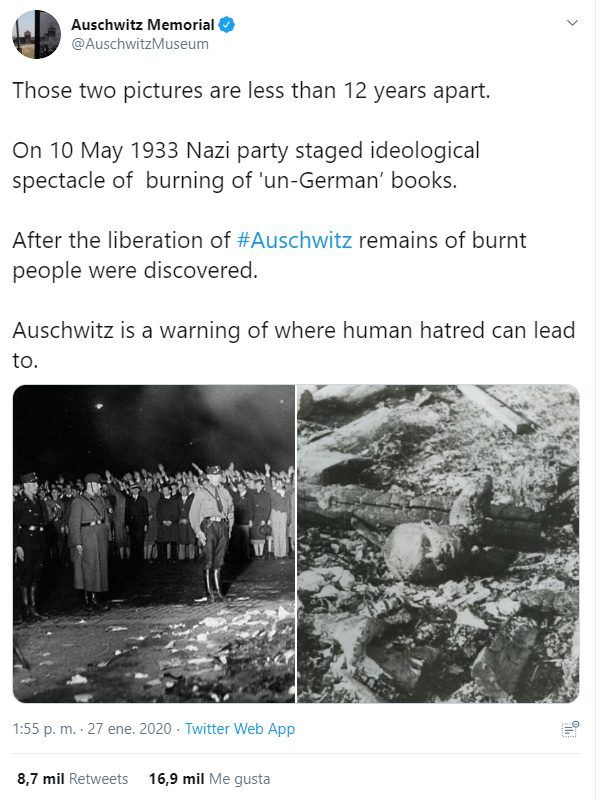

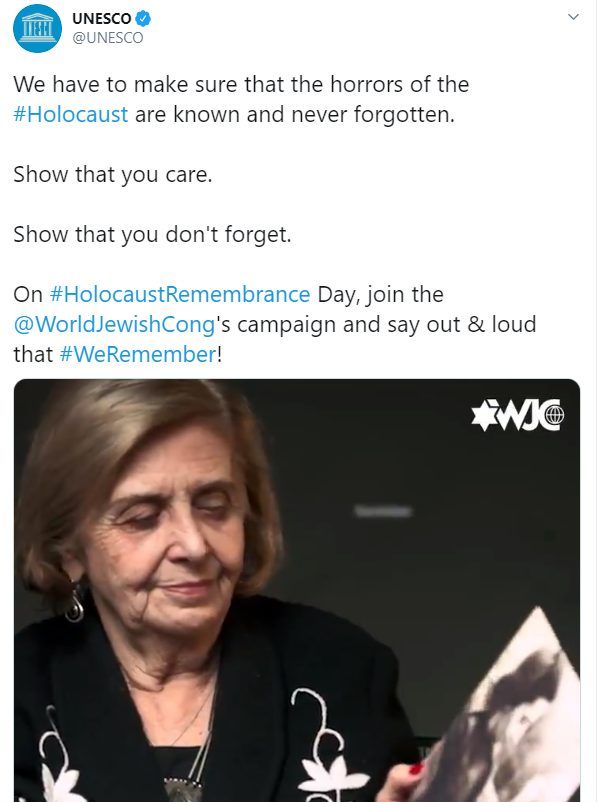
Europe Day
Europe Day, which is celebrated on 9 May to commemorate the 1950 Schuman Declaration, is a key date on the European calendar and its celebration is a trending topic in social media. To be exact, between 6 and 13 May 2019, the data collection effort used a combination of web scraping and API monitoring to find 24,222 tweets (with a reach of as many as 114,447 through retweets). In 2020, between 8 and 14 May 2020, the number of tweets was 44,929 (reaching up to 218,149 through retweets). In other words, the impact at a quantitative level nearly doubled from 2019 to 2020. To understand these figures, however, it is necessary to bear in mind that Europe was in widespread lockdown at the time and the use of social media was greater. As a result, the doubling cannot be explained solely by the increased popularity of Europe Day. In particular, the year 2020 marked the seventieth anniversary of the Schuman Declaration, another element to bear in mind. The search focused on the hashtags #DiaDeEuropa, #DíaDeEuropa, #DiadEuropa2020, #9deMayoDíaDeEuropa, #FelizDíaDeEuropa, #EuropeDay2020, #EuropeDay, #Europatag, #diadaeuropa, #fetedeleurope, #JourneeDelEurope, #70Schuman, #Schuman70. For this sampling, however, it has not been possible to incorporate any content without a hashtag (typically more numerous) that included key words like “Día de Europa” or “Europe Day” because of the high probability of false positives, nor was “9 de mayo” included because 9 May is officially the date of the celebration of Victory Day in Moscow (see Chart 4 below).
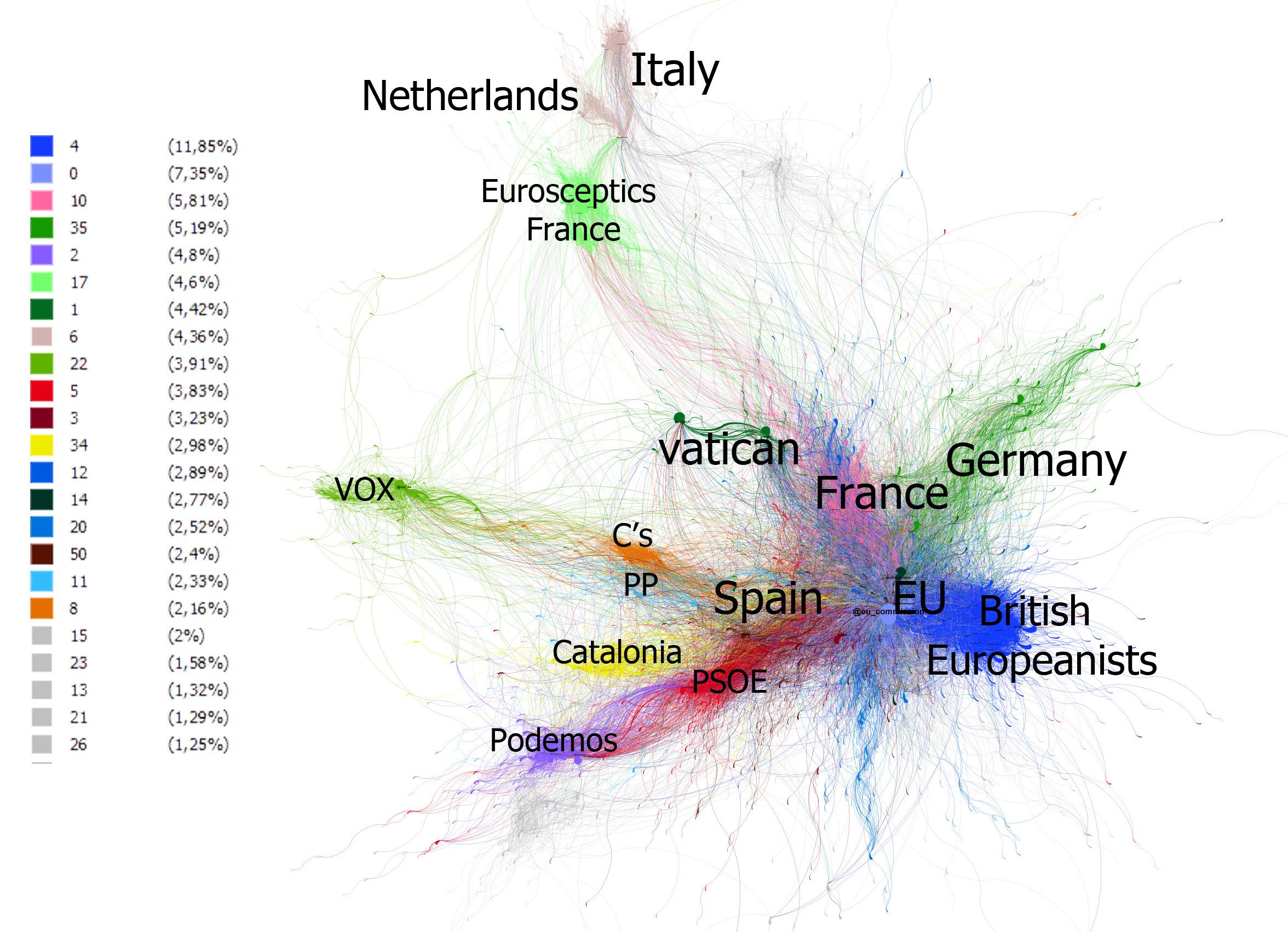
Chart 4. Distribution of communities by hashtag.
The spread of content by identified communities has been very dispersed: nearly 20% of the profiles belonged to groups that were isolated or contained fewer than 1% of all participants. Within the analysed chart, the communities identified linguistically or ideologically are also highly fragmented between pro-Europeans and Eurosceptics (see Chart 5 below). Like last year, the European Commission and its offshoots appear as an important community (7.35%) in the middle of the chart at the epicentre of the phenomenon. By contrast, the most numerous community overall is made up of British pro-Europeans (11.95%). Also prominent is the participation of Spain and the structure of reach by political party: Unidas Podemos (4.8%), Vox (3.91%), PSOE (3.82%), Catalan parties (2.98%) and Ciudadanos (2.18%). A separation between the right and the left is apparent in the language communities within each state or political entity. In France, a separation can also be observed between pro-Europeans (5.81%) and Eurosceptics (4.6%), while Italy (4.36%) is very close to the latter. There was already a separation in France on Europe Day in 2019, but the Eurosceptic group was smaller. At a comparative level, the largest change has occurred in Italy, which has moved away from positions close to the EU in 2019 and shifted in the direction of the Eurosceptics. In addition, the celebration of Europe Day in 2020 has seen the appearance of the Vatican (4.42%) through its account @pontifex, which forms a bridge between the Spanish right and French pro-Europeans.
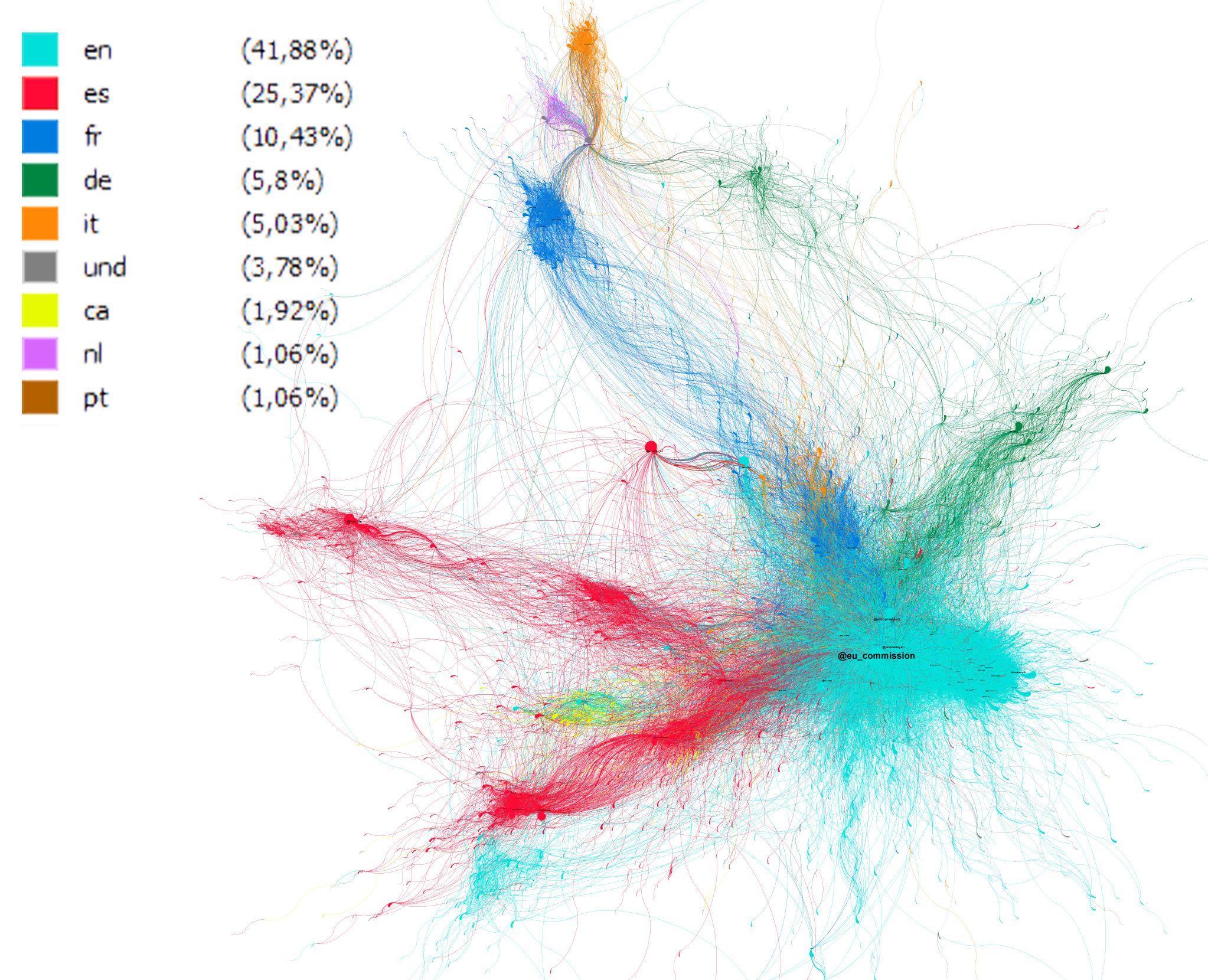
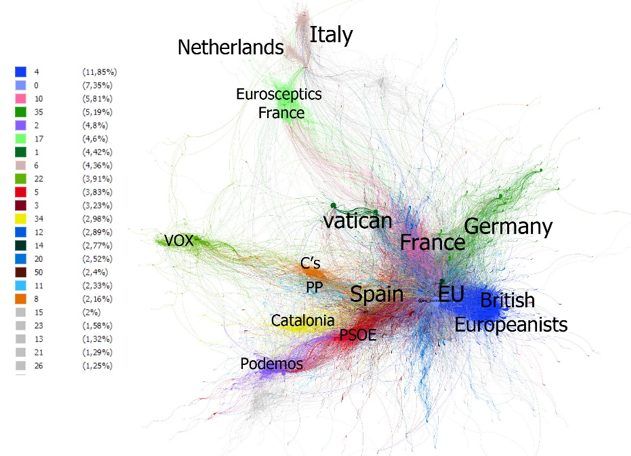
Chart 5. Language communities (above) and affinity communities (below).
The distribution by language was generally dominated by English (41.88%), which was used by British pro-Europeans and the groups closest to the European Commission (which were the ones to generate the greatest number of tweets). The language ranked second was Spanish (25.37%), which was used by all political parties in Spain except for the Catalan ones. Ranked third was French (10.43%), followed in fourth place by German (5.8%) and in fifth place by Italian (5.03%). Catalan was present in 1.92% of the tweets and Dutch in 1.06%. In comparison to the previous year, there has been a decline in linguistic diversity and an increase in the hegemony of English.

Chart 6. Comparison of languages in use (English-Spanish-French-German-Italian-Catalan).
In the content analysis, the tweets with the greatest impact were once again put out by the European Commission in relation to the Schuman Declaration (3,900 retweets) and to the need to overcome the Covid-19 crisis politically, which included a video with messages of support from the principal leaders of the EU (830 retweets) (see images below). In comparison with the previous year, it is important to highlight that in 2019 all of the posts from the account @UE_Commission had only 3,772 retweets, so we can observe an increase in the institution’s reach in social media.
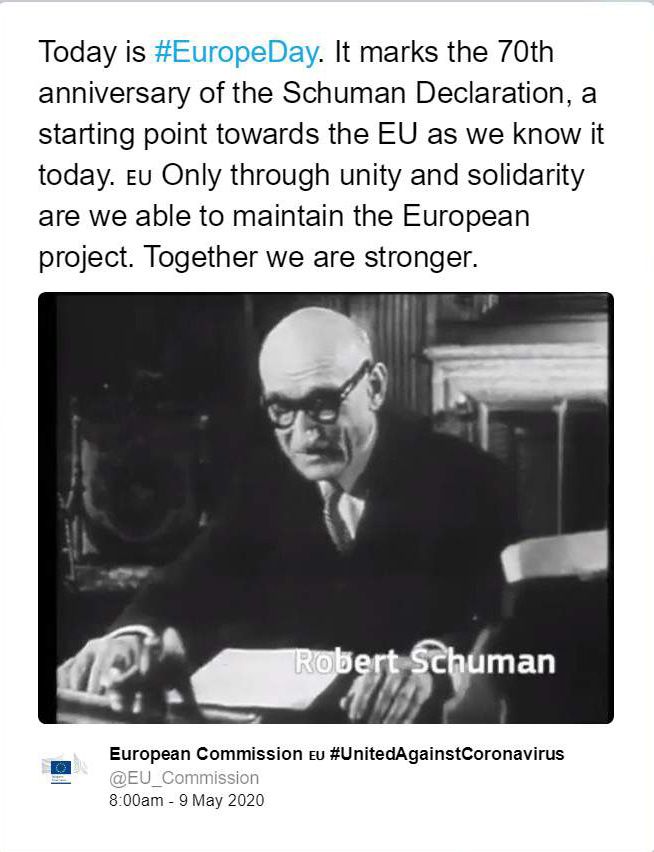

However, as noted earlier, the ability to make quantitative comparisons is limited by the methodology used in the first half of 2019. As a consequence, we can offer a detailed analysis of the most prominent trending topics in 2020, but we cannot make a retrospective comparison. In this respect, the analysis of the content on Europe Day has formally been divided into pro-Europeans and Eurosceptics, because they are the most representative positions in dispute over the commemoration.
Among the so-called pro-Europeans, we can identify a large community with greater activity in the United Kingdom. The UK has recently left the EU after intense social debate surrounding the Brexit referendum, which resulted by the narrowest of margins in forcing the country’s departure. In the pro-European community, the tweet with the greatest impact was posted by the political analyst Derek James (@derekjames150): “On #EuropeDay2020, how many of you wish the UK was still a member of the EU?” Leading politicians, particularly members of the Labour Party, also had a major impact in the group. For example, David Lammy (@DavidLammy) tweeted: “On #EuropeDay we celebrate the Schuman Declaration which led to the most successful peace project in history. Let’s show solidarity to our European friends and neighbours in the UK and across the continent. This crisis has shown we are so much stronger when we are united”. Also, Richard Corbett (@RichardGCorbett) tweeted:
“Today is #EuropeDay, anniversary of the #Schuman Declaration, which triggered what later became the European Union, to create “the basis for a broader& [sic] deeper community among peoples long divided by bloody conflicts & to lay the foundations..for a destiny henceforward shared”.” The overall thrust, broadly speaking, was to challenge Brexit by means of discourses centred on the idea of fraternity. Noteworthy in this respect was the absence of a contrary discourse in the UK from Brexiteers, who are generally highly active in social media but were not very mobilised on this occasion.
Turning to France’s pro-European community, the most popular tweet was posted by President Emmanuel Macron, who quoted President of the European Council Charles Michel and posted a video released by the previous European Commission. Macron’s discursive line sought to use the celebration to address the Covid-19 crisis by drawing a political parallel between the foundation of the EU and its present adversity (see image below). This sort of narrative was prevalent on Europe Day. The remainder of the most popular tweets from the community were posted from institutional profiles, media outlets and politicians serving in Macron’s government. By contrast, the tweet in Germany that had the greatest impact and reach came from an activist called Daniel Mack (@danielmack), who posted a timeline that showed the continent’s periods of war and peace and stated that the European Union “ist das Beste, was uns passieren konnte” [“is the best thing that ever happened to us”] (see image below). Among Spain’s pro-European community, the most popular tweet was posted by the multifaceted communicator Javier Aroca, who recalled the EU’s early principles of solidarity, especially toward Germany, in a clear allusion to the current situation and the need to apply the same principles to Southern Europe against a backdrop of systemic crises (@JavierArocaA: “En virtud del Acuerdo de Londres de 1953, se condonó, anuló o hubo una quita de la #deudaexterioralemana. Entre los condonantes estaba España y todos los Estados del sur de Europa. Feliz #DiadeEuropa. En particular a #Alemania” [“By virtue of the London Agreement of 1953, Germany’s external debts were forgiven. Those who agreed to write off the debts included Spain and all the nations of Southern Europe. Happy #DiadeEuropa. Especially to #Alemania”]). In the same vein, the Second Deputy Prime Minister Pablo Iglesias quoted Schuman and posted an excerpt of the declaration to argue on behalf of the same fundamental organising principle (@PabloIglesias: “ “Europa no se hará de una vez ni en una obra de conjunto: se hará gracias a realizaciones concretas, que creen en primer lugar una solidaridad de hecho”. Declaración Schuman, 9 de mayo de 1950. La solidaridad debe ser la base de una Europa unida y democrática. #DiaDeEuropa” [“ “Europe will not be made all at once, or according to a single plan. It will be built through concrete achievements which first create a de facto solidarity”. Schuman Declaration, 9 May 1950. Solidarity must be the foundation of a united and democratic Europe”]). Indeed, most of the content posted by pro-European politicians in Spain harked back to unity and solidarity as values before the current crisis in the hope that a solution would not impose austerity and cutbacks in social spending as a formula to overcome the crisis. This line is similar to the one adopted by Pope Francis, who was especially active throughout the day from his Vatican profile.
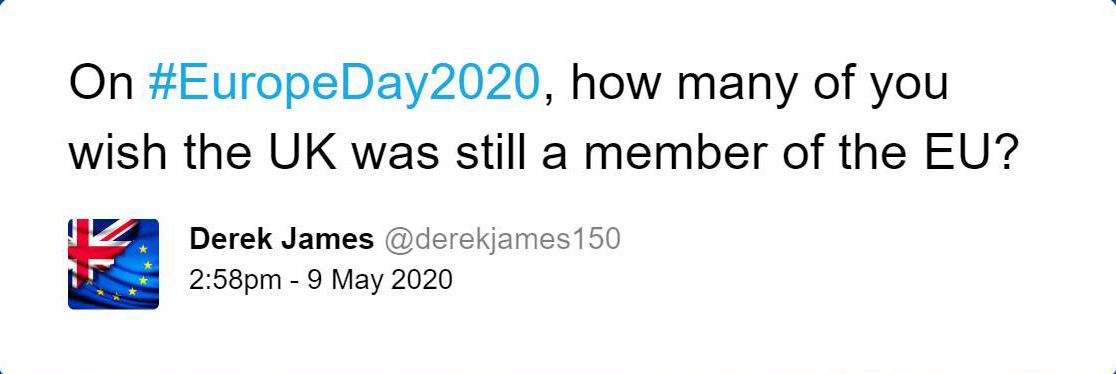
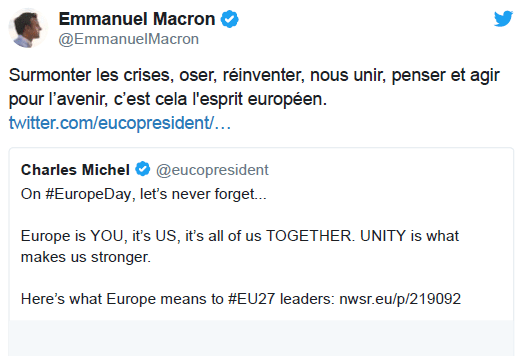
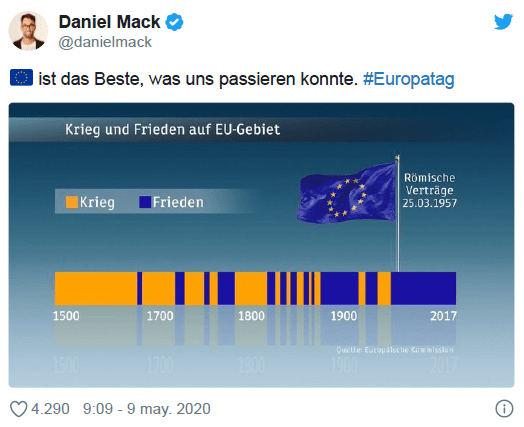
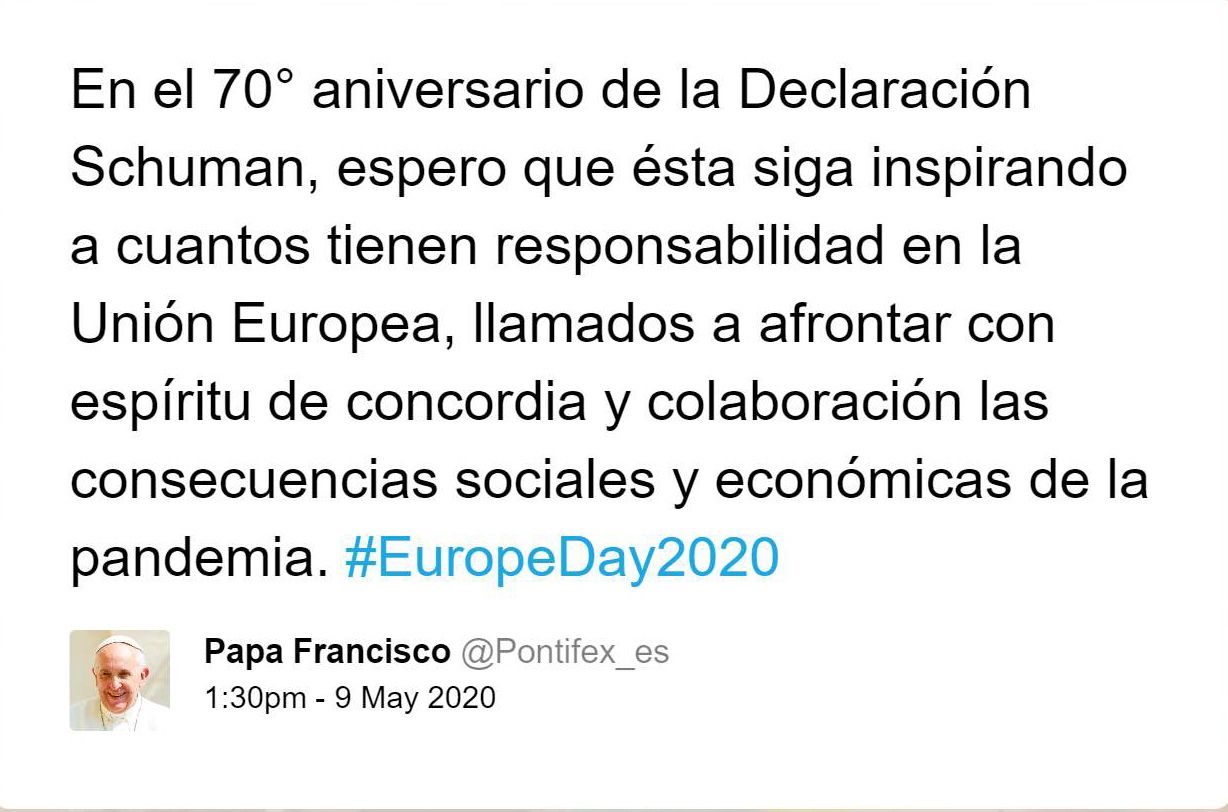
In the case of the Eurosceptic community, we noted earlier that its presence on the platform has witnessed continued growth. In France, where the phenomenon is most pronounced, the tweet with the greatest impact came surprisingly from an anonymous profile with very few followers (345). The tweet introduced a survey on France’s membership in the EU and the result showed that 88% of respondents opposed the EU. Also promoting this way of thinking was a tweet posted by the politician Nicolas Dupont-Aignan (@duponaignant), who is a founder of the right-wing populist party Debout la France. Prominent in Dupont-Aignan’s discourse was the economic cost of sustaining the EU: “Triste ironie ! Les Français qui travaillent dur sont matraqués fiscalement pour financer 23 milliards€/an une Union européenne qui exonère les GAFA d’impôts, protège les paradis fiscaux, instaure la concurrence déloyale… Assez de cette Europe devenue folle ! #journeedeleurope” [“Sad irony! The hard-working French are clobbered with taxes to send 23 billion euros to a Union that exempts the big four tech giants from paying taxes, protects tax havens, establishes unfair competition… Enough of this Europe gone mad!”]. The profile of the popular tweeter Kelly Betesh, who has over 15 million followers, also had a major impact on the day based on her posting of a photo in which she wrapped herself in the French flag in rejection of Europe Day (see image below).
Other examples of Euroscepticism on Twitter appear in Italy and the Netherlands. In these communities, the tweet with the greatest impact came from the account @Jeroen99271706, which posted an image of the EU flag being set on fire in protest. Mention should also be made of the widespread dissemination of a video tweet from the journalist Giorgio La Porta, which promoted an explicit criticism of the EU (@giorgiolaporta: “Io mi ricordo quando #DiMaio chiedeva l’uscita dall’#Euro. Diffondete questo video. Dedico la #FestadellEuropa agli elettori traditi da quel #M5S che da #noEuro è finito al #Governo con il #Pd delle banche e ha votato per l’attuale Commissione.#30denari #EuropeDay #9maggio” [“I remember when #DiMaio called for withdrawal from the #Euro. Pass on this video. I dedicate the #FestadellEuropa to voters betrayed by that #M5S of #noEurope that ended up in the #Governo (in government) with the #PD of the banks and has voted for the current Commission.#30denari #EuropeDay #9maggio”]). It is important to underscore that most of the tweets from Italy’s Eurosceptic community centred on the political milieu of the Lega Party on the ideological right. In the case of the Netherlands, the politician Geert Wilders (@geertwilderspvv), leader of the far-right PVV Party, went viral with the post of an explicit photo under the slogan “Nexit”, in a clear allusion to Brexit. Wilders’ tweet also called for a referendum on leaving the EU. Lastly, in Spain, the far-right Vox Party and its followers were the primary sources of Eurosceptic content, posting tweets with references to national sovereignty and the fight against illegal immigration. One of the tweets posed the question “¿Forma parte de la ‘Nueva normalidad’[19] conseguir que las naciones europeas se disuelvan para crear una nueva Pangea sin identidad, al margen del control de los ciudadanos y dirigida por seres como Soros?#DiaDeEuropa” [“Is it part of the ‘new normal’ to get the nations of Europe to disband in order to create a new Pangaea with no identity, beyond the control of citizens and led by human beings like Soros?#DiaDeEuropa”], which was accompanied by an image of Open Arms, a rescue ship that operates in the Mediterranean. Similarly, a deputy in Andalusia’s parliament, Luz Belinda Rodríguez, posted a tweet that went viral in which she said that “[l]a UE no es Europa. Europa es la filosofía griega, la tradición de sus pueblos (íberos, celtas, germanos, eslavos…), el derecho romano y los valores cristianos. Unidad cultural y respeto por las soberanías nacionales. En el #DiaDeEuropa reivindiquemos a la verdadera Europa” [“the EU is not Europe. Europe is Greek philosophy, the tradition of its peoples (Iberians, Celts, Germans, Slavs, etc.), Roman law and Christian values. Cultural unity and respect for national sovereignties. On #DiaDeEuropa we stand up for the real Europe”], and she accompanied her tweet with an image of the EU flag struck through with a cross in the colours of the Spanish flag (see image below).
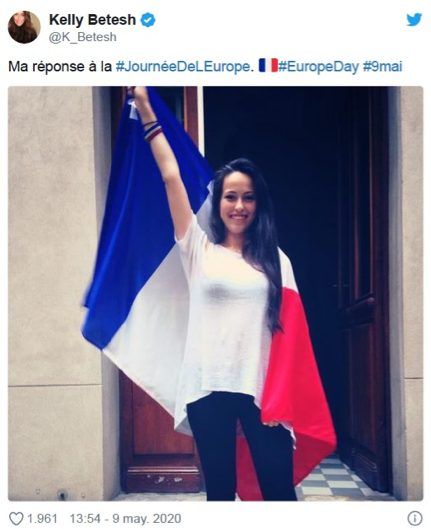

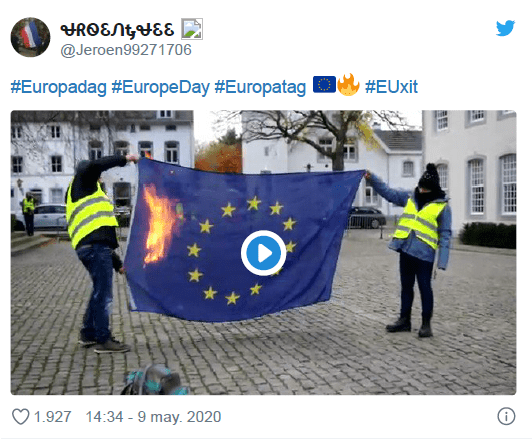
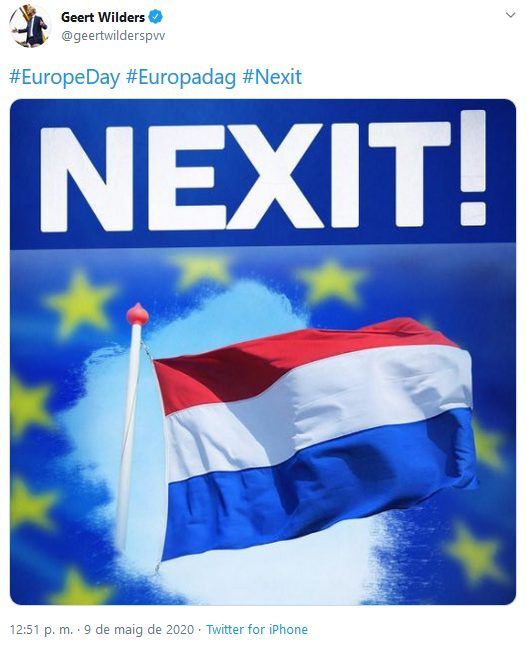

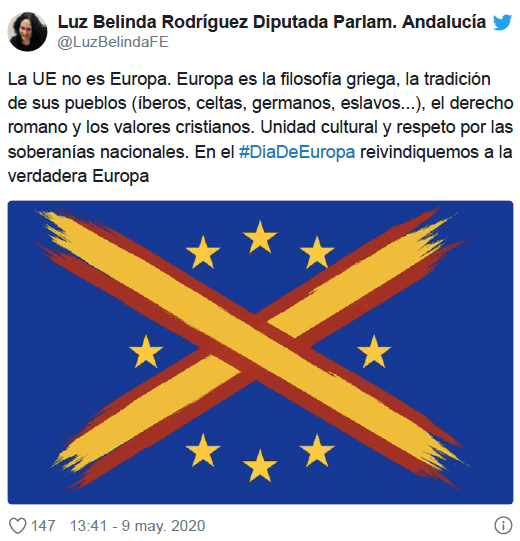
To conclude the content analysis, it is necessary to look at the threads of tweets that could be called Eurocritical, an area that lies at one end of the pro-European group and tilts towards the Eurosceptic community but is not part of it (see Chart 5 again). Unlike the Eurosceptics, Eurocritical sectors are mostly located with the parliamentary left that does not support a break with the European Community, but calls instead for democratising reform. One example would be a tweet from the Euro MP Erik Marquardt of the Greens/EFA Alliance. Marquardt’s tweet, which was critical of EU practice, was quite popular (@ErikMarquardt: “Das große Problem der Europäischen Union ist nicht Brüssel, nicht Strasbourg, nicht die Kommission oder das Parlament. Das Problem sind Nationalstaaten, die Europa blockieren und Regierungen, denen die nächsten Wahlen wichtiger sind als die nächsten Generationen. #Europatag” [“The EU’s big problem is not Brussels, nor Strasbourg, nor the Commission, nor the Parliament. The problem is the nation-states that are blocking Europe and the governments that are more concerned with the next elections than with the next generations.”]). Indeed, the Eurocritical strand was a highly identifiable trend in the German pro-European community. For instance, another tweet that had considerable impact came from Sawsan Chebli of the SPD, who seized on Europe Day to criticise the EU’s migration policies (@SawsanChebli: “Was mögen wohl die Geflüchteten über den #Europatag denken, die seit Wochen im Camp #Moria auf Lesbos festgehalten und teilweise wie Tiere behandelt werden? Was die Mütter und Väter, die ihre Kinder auf dem Weg nach Europa verloren haben?” [“What do refugees think about #Europatag (Europe Day), held in the #Moria camp on Lesbos for weeks and sometimes treated like animals? What about the mothers and fathers who lost their children on the way to Europe?”]). These spaces had room too for humour and memes, such as the one that accompanied a tweet from Ulrike Guérot (@ulrikeguerot), a founder of the EU reform movement called European Democracy (see image below), which went: “Heute, am 9. Mai 2020, zum 70. Geburtstag der Europäischen Gemeinschaft von Kohle und Stahl, fordern wir, eine Allianz aus europäischen NGOs, die Weiterentwicklung der EU zu einer veritablen europäischen Demokratie! #CitizensTakeOverEurope #9May #EuropeDay Dial in:)” [“Today, on 9 May 2020, on the 70th anniversary of the European Coal and Steel Community, we an alliance of European NGOs call on the EU to become a real European democracy! #CitizensTakeOverEurope #9May #EuropeDay Dial in:)”]. In Spain, a cartoonist at the satirical magazine @eljueves also resorted to humour (see image below).
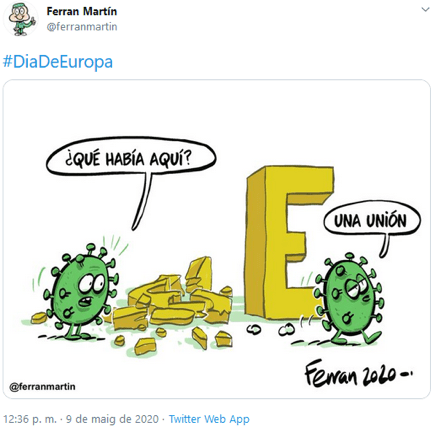

Commemoration of the Second Spanish Republic
As noted earlier, the date of 14 April is not an official commemoration on the Spanish calendar. Consequently, it features no public ceremonies of tribute or institutional memory at the level of the Spanish state, although there are sometimes events at the municipal level. In addition, the date’s celebration continued underground during the long years of the Francoist dictatorship, surviving decades of exile and silence in an act of symbolic resistance that was markedly anti-fascist in character. The social value that a swathe of the population ascribes to 14 April, which links the Second Spanish Republic to freedom and democracy, has kept the commemoration alive through intergenerational transmission. As a result of these elements, it is also a controversial date marked by conflict and used often as a political weapon between the left and the right. At this point, the past has become a battlefield and a tool of political action. The date’s online footprint is therefore valuable for social scientists who analyse official and informal commemorations, their tensions and their uses.
First, a comparison with the previous year indicates that the commemoration’s impact in social media has grown sharply from one year to the next. Specifically, in 2019, the number of tweets between 12 and 17 April was 11,180 (rising to 86,714 through retweets). By contrast, between 12 and 29 April 2020 (with a larger sampling rate), the number of tweets was 36,296 (rising to 216,404 through retweets).[20] In other words, the phenomenon tripled from 2019 to 2020. However, the explanation lies in greater access to the platform and increased online activity as a result of strict lockdown measures in force at the time in Spain. It is not so much a result of the longer timeline, given that nearly all of the tweets were posted between 14 and 16 April, just as they were in the previous year (see Chart 7 below). More instructive is a comparison between 14 April and festivities at the European level, such as Europe Day, which are aimed at a wider audience and have broad institutional support. A comparative analysis of the content shows the major impact that the date continues to have among the Spanish population as well as the population’s enormous activity on the platform.
At a methodological level, the most popular hashtags on the date were #14deAbril (22.51%), #14abril (21.53%), #14deabril (1.05%) and #14AbrilRepublicaYa (0.45%). As in the previous year, the hashtags are generally variations of the same wording with different upper-case and lower-case combinations. It is important to bear in mind, by contrast, that related tweets without a hashtag generated an enormous amount of content in 2020, accounting for 36.18% of the total. This stands in stark contrast to 2019, when they accounted for only 5.04% of the total. Prominent among the words without a hashtag were “14 abril república” [“14 April Republic”] and “subcampeones 1939” [“runners-up 1939”].
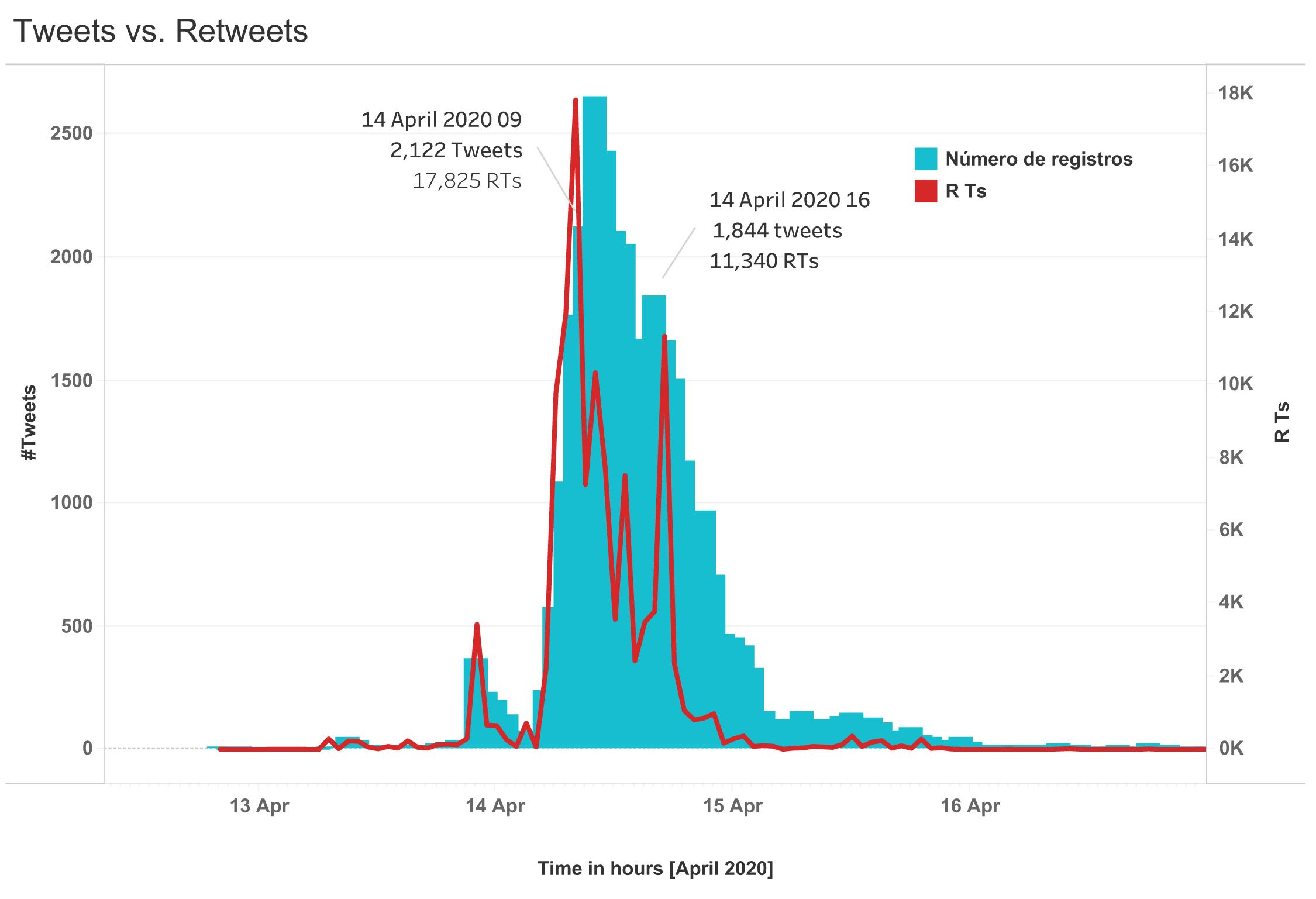
Chart 7. Spread of tweets by hour and day.[21]
After tracking the data and content, it has been possible to identify communities that, as noted earlier, point to enormous polarisation and politicisation with very little permeability between the groups. Indeed, the attached chart shows two perfectly identified blocs, which are separated from one another and have very few interconnections: the bloc on the left, which is larger, is in favour of commemorating the Second Spanish Republic, while the bloc on the right is opposed. In this respect, we can also observe that the communities are all smaller than 10% with the exception of the far-right group, which is the largest and most compact (19.25%) (see Graph 8 below). This indicates that there was no unified campaign to commemorate the anniversary by those who support its celebration and remembrance. Accordingly, the left-wing group can be divided into sub-groups associated with political parties, such as Unidas Podemos, the Socialist Party (PSOE), Republican groups, the Catalan political spectrum (connected mostly with Podemos) and groups engaged in satire, humour and the creation of memes. Oddly enough, the connections between the blocs on the left and on the right were made by satirical and ironic profiles.
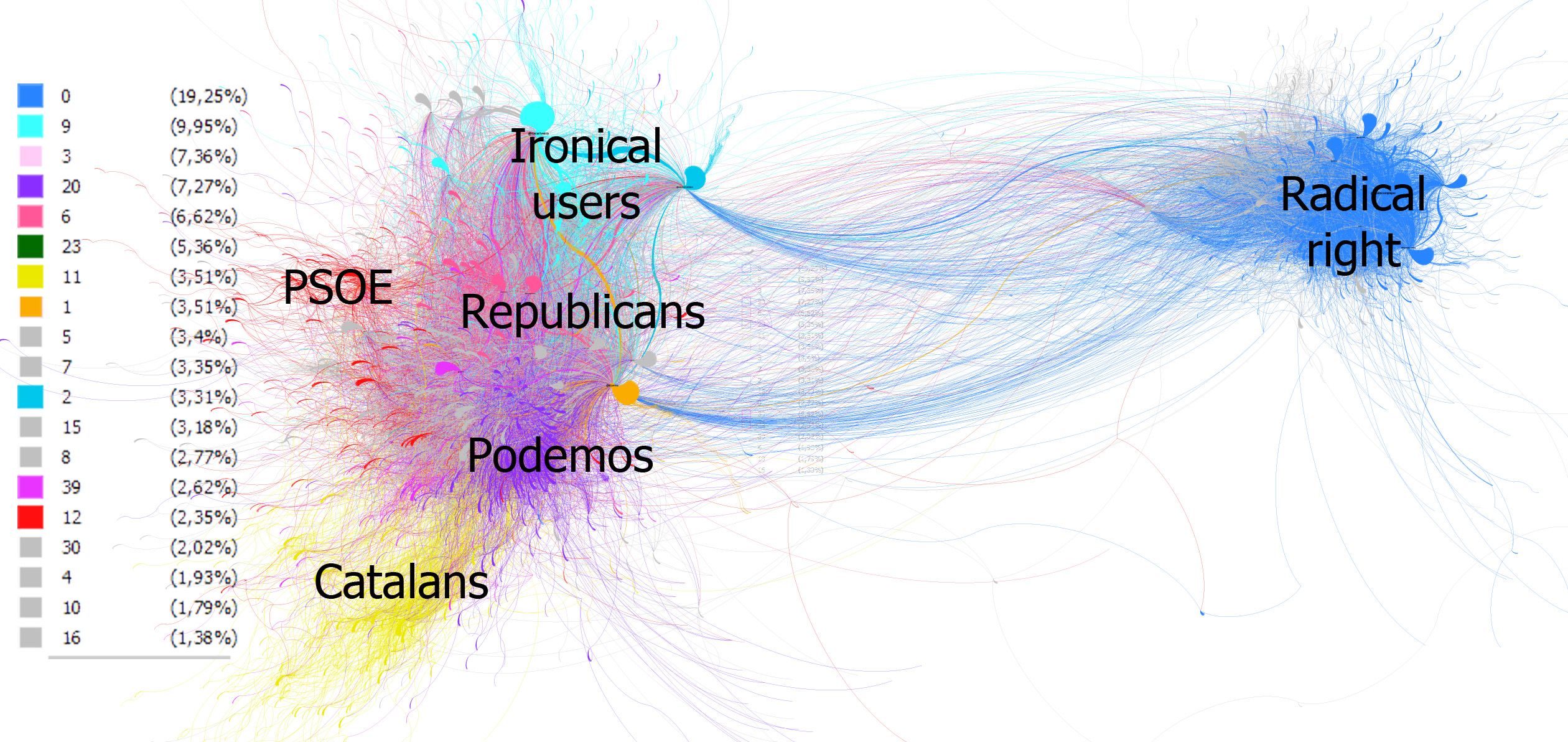
Chart 8. Specific spread on the commemoration of the Second Spanish Republic.
Indeed, the first sequence of the analysis resulted in an initial chart (see Chart 9 below) that actually showed four areas associated by ideology and geography. In this vein, it is important to bear in mind that 14 April is also Pan American Day. This accounts for the appearance of two ideologically separate Venezuelan groups who both used the hashtag #14abril. The remaining two groups correspond to profiles that posted tweets related to the commemoration of the Second Spanish Republic, which can be seen in Chart 8 above. However, the Venezuelan groups appearing in the initial chart (Chart 9) accounted for less than 1% of the profiles and they were connected through interactions with the groups posting on the Second Spanish Republic. As can be observed in Chart 9 below, the groups are only slightly connected domestically or with those elsewhere who have the same ideological affinity, but there is hardly any connection linking the different ideological groups of different countries (for example, between the Spanish left and the Venezuelan right). Therefore, to restrict the context to the spread of tweets related to the Second Spanish Republic, the Venezuelan groups were removed.

Chart 9. Network of spread by community.
By contrast, a number of methodological problems cropped up in the linguistic analysis of the commemoration and we were therefore unable to draw conclusive results. The conclusion of the language distribution points to a majority of content in Spanish (88.88%), while the content in Catalan amounts to only 4.17%. This finding raises doubts over the interpretation, because the Catalan-speaking community rather surprisingly ranks fifth worldwide in the generation of content on Twitter and also accounts for approximately 20% of Spain’s population. Therefore, the extracted data do not appear to reflect their likely participation, nor the participation of the other languages in use in Spain, such as Galician and Basque, which have a smaller presence on the platform. As a result, this snapshot appears to be attributable to the lack of words in Catalan and other languages being incorporated in the tracking, which is an element that will be addressed in subsequent analyses at the Spanish state level in order to correct the methodology and reflect the linguistic diversity that is doubtless on the rise because of new communities.
As for the content analysis, the accounts have been separated into different ideological communities. Beginning with the far-right, which opposes the commemoration, the tweet with the greatest impact was posted by a journalist at the right-wing media outlet Libertad Digital, Luis del Pino, who seized on the opportunity to recall Republican repression against other Republicans (@idpsincomplejos: “Recuerda: Clara Campoamor, la defensora del voto femenino, gracias a la cual se aprobó ese avance, tuvo que huir de Madrid a Francia por el miedo a ser asesinada por los republicanos” [Remember: Clara Campoamor, champion of women’s right to vote, thanks to whom that advance passed into law, had to flee from Madrid to France out of fear of being murdered by the Republicans”]). A similar discursive line appeared in a tweet from Vox parliamentary deputy Ignacio Garriga, who posted a breakdown of the clerics murdered during the Spanish Civil War as a way to criminalise the Second Spanish Republic (see image below). From a different social profile, another tweet that had a major impact was an anti-Republican poem posted by Padre José María, a priest who is very active in social media (see image below). Lastly, members of the community also took the opportunity to rail against the Spanish government for its handling of the Covid-19 crisis. They used a number of tweets posted by members of the centre-left governing coalition made up of the PSOE and Unidas Podemos on the subject of the commemoration. For example, the online media outlet Caso Aislado (@CasoAislado_Es) quoted the Second Deputy Prime Minister Pablo Iglesias (Podemos) to say: “Con más de 18.000 muertos, la prioridad del vicepresidente del Gobierno Pablo Iglesias, hoy #14deAbril, no son los españoles ni las miles de familias que están sufriendo la pérdida de familiares y amigos, sino conseguir la República. Qué miserable es” [“With over 18,000 deaths, the priority of Second Deputy Prime Minister Pablo Iglesias, on today #14deAbril, is not the Spanish people or the thousands of families that are suffering the loss of relatives and friends, but to achieve the Republic. How squalid”].
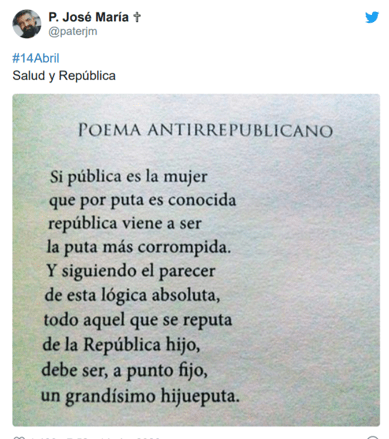
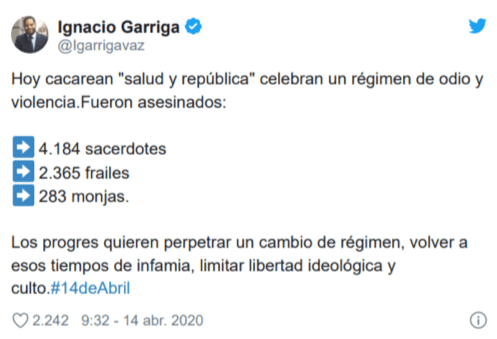
An in-depth look at the profiles in the left bloc points to three types of narratives: tweets that recall the date in its historical context (in commemoration), tweets that use the commemoration to challenge the present monarchy, and tweets that connect the date to the pandemic, such as the one from Ione Belarra, Podemos parliamentary deputy (see image below). In other words, we can observe a much more explicit political use in the latter two groups. In relation to the second group, it is necessary to take into account the various corruption scandals that have beset the royal family in recent years, especially Spain’s emeritus king Juan Carlos I, and have brought the institution into sustained disrepute in public opinion. The largest share of the second group’s most prominent tweets were posted by civilian profiles, but also by politicians in Unidas Podemos, such as the parliamentary deputy Juanma del Olmo (@juanmalpr: “El rechazo a la monarquía está inspirado en tres elementos: es una institución del pasado, está salpicada por la corrupción y no es una institución democrática. Una mayoría de españoles se pregunta ¿para qué sirve la monarquía? #14Abril #Viva la República #Salud y República” [“The rejection of the monarchy is inspired by three features: it is an institution of the past, it is tainted by corruption and it is not a democratic institution”]). By contrast, other profiles such as Eco Republicano (@EcoRepublicano), which was also one of the most prominent on the date in 2019, evinced irony in response to Queen Leticia’s return to work after the lockdown (see image below). Along the same lines, journalists like Lucía Nistal, at izquierdadiario, raised a question about the costs of maintaining the monarchy and the possibility of redirecting the funds to bolster the healthcare system, which was overwhelmed at the time (see image below).
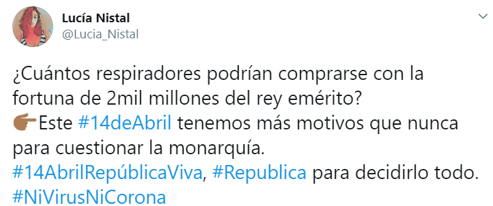

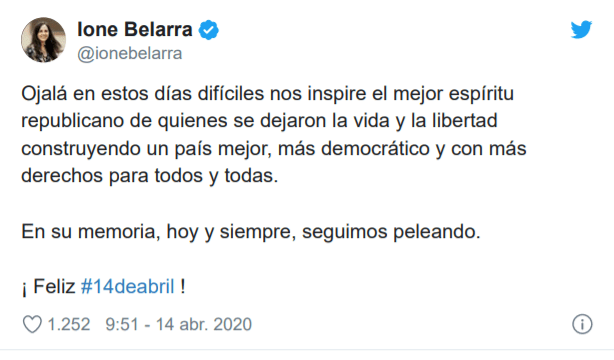
Prominent among the profiles of the Catalan community (which is ideologically heterogeneous, but generally located with the left bloc on the date) is the weight of the national question. In recent years, Catalonia has experienced a political conflict revolving around the issue of its sovereignty and independence, which reached a high point in the autumn of 2017, when a unilateral referendum on independence took place, and again in 2019, when the legal sentences arising from the events of 2017 sparked a wave of street protests. As a result, much of the content used the idea of the Republic to call for a Catalan Republic. Among the group’s tweets, the most popular was posted by Josep Costa, a deputy in Catalonia’s parliament for the Junts Per Catalunya Party (@josepcosta: “Ara només tenim una prioritat: lluitar contra la Covid-19 i fer costat a les seues víctimes.Però avui és un bon dia per renovar el compromís que, quan tot passi, no descansarem fins a foragitar definitivament la corrupta monarquia borbònica del nostre país. #14Abril #República” [“We now have only one priority: to fight Covid-19 and give support to its victims. But today is a good day to renew our pledge that, when all of this is over, we shall not rest until we have finally rid our country of the corrupt Bourbon monarchy. #14Abril #República”]). Also quite popular were tweets posted by Plataforma 3 de Octubre, a platform that grew out of a merger of civil society and trade union organisations that called for the general strike of 3 October 2017 against police repression during the referendum. Indeed, the platform used the date to call for a protest against the monarchy in the form of a cacerolada, which is a form of popular protest when citizens bang on pots and pans from their balconies or open windows (see image below). Also prominent among the Catalan community was a tweet posted by Malcolm iXa (@ideazabaldu), who seized on the opportunity to celebrate the Republic and make an appeal to internationalism among the peoples of Spain and to Spain’s plurinational character (see image below).
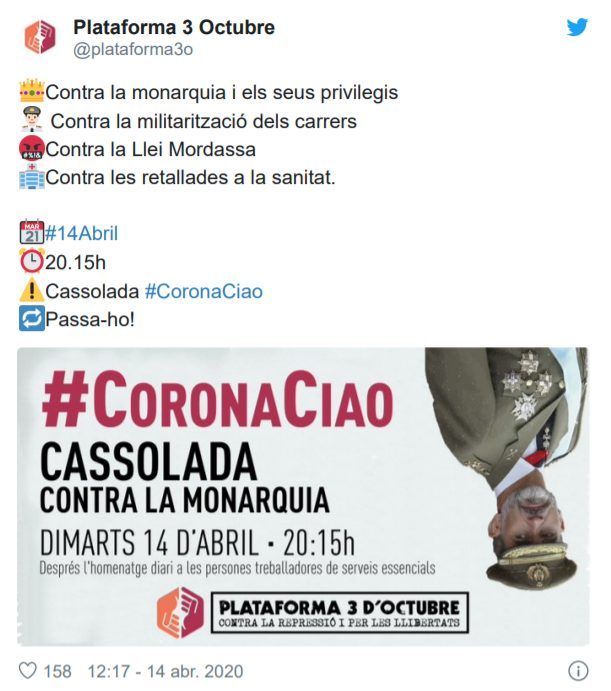
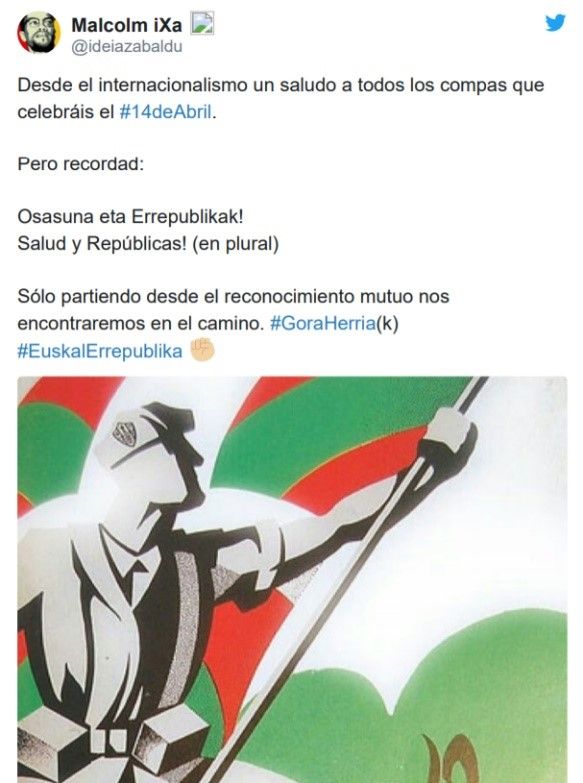
One last phenomenon that proves interesting to analyse is the presence of humorous and satirical accounts that have used memes and cartoons to generate diverse content and that have served as a connecting link between the two communities (although they can be found ideologically in the left bloc). Generally, the community of cartoonists and satirists is made up of anonymous or civilian profiles, which produce viral content without much political signification targeted at any given party in particular. Within the community, the tweet with the greatest impact was posted from the account of Sara Riveiro, a communications student with little more than 4,000 followers. In her tweet, Riveiro quoted a tweet posted by the Spanish Prime Minister Pedro Sánchez on 14 April 2014, together with a photo of a street named after the date under the heading “Salud y República” [“Health and Republic”]. The profile used this event from the past to call for the realisation of its aim, given the political power that Sánchez now has (but then did not have) as Spain’s head of government (see image below). Another tweet that had a major impact was posted from an anonymous profile (@aaroncp15), which referred ironically to content produced by far-right profiles using the hashtag “subcampeones de 1939” [“runners-up of 1939”] in allusion to the Republican defeat in the Spanish Civil War, which ended in 1939. The anonymous tweet, which went viral, used the same concept to create a montage bearing the title “subcampeones de 1945” [“runners-up of 1945”] together with photos of the losers of the Second World War.
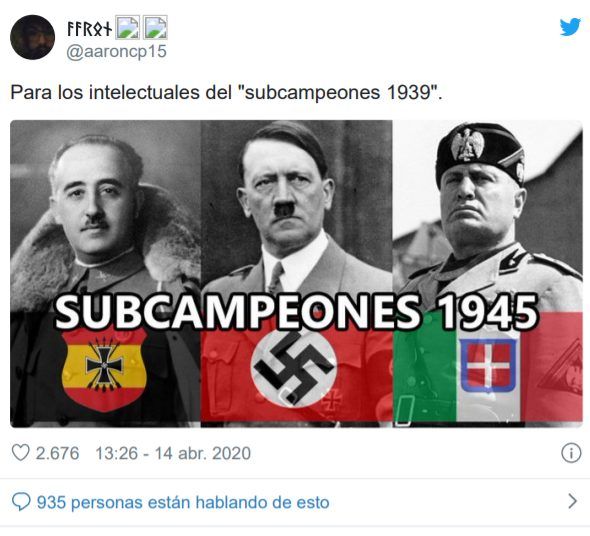
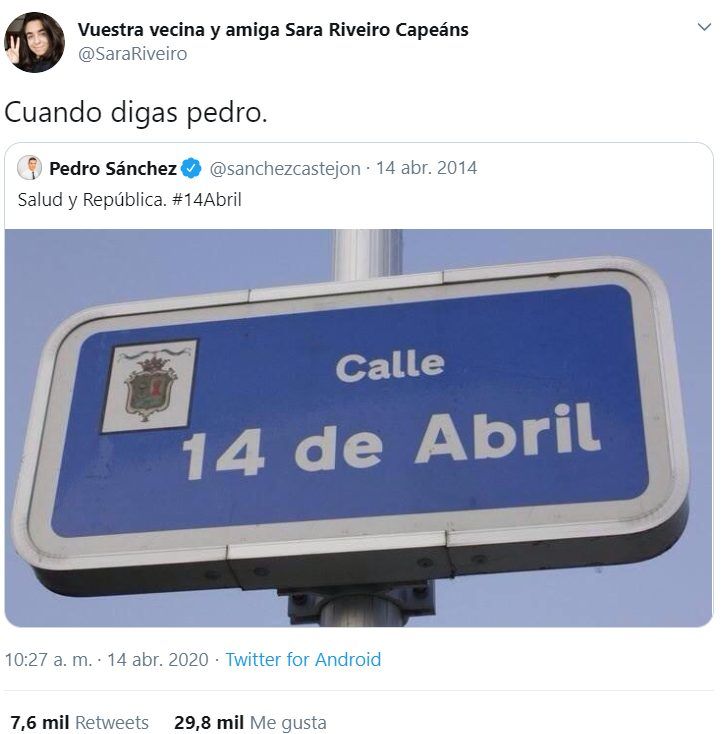
In conclusion, the commemoration of the Second Spanish Republic in 2020 not only continued to be a phenomenon on the platform, but it also saw substantial growth in relation to the previous year. Its celebration continues to be a socially alive act of remembrance and a political element of conflict and confrontation. Poor management of the memory of the past and the Francoist dictatorship partly accounts for the date’s use as an ongoing political tool between the left and the right as a response to the narrative of winners and losers, fascism and anti-fascism. The polarisation of the two communities, which are more sharply segregated than any of the communities related to the other commemorations that are more broadly European in character, is a clear example of the persistence of narratives surrounding the Spanish Civil War.
[1] See: Katz, Martín & Jung, 2020. Available at: https://papers.ssrn.com/sol3/papers.cfm?abstract_id=3600829.
[2] See: Ojo, 2020. Available at: https://papers.ssrn.com/sol3/papers.cfm?abstract_id=3613234.
[3] See Dr. Congosto’s main publications at: https://uc3m.academia.edu/MariLuzCongostoMartinez.
[4] See Dr. Muñoz Martínez’s CV at: http://www.gesafrica.org/munoz-martinez-celeste/
[5] For more information, consult: http://www.trendinalia.com.
[6] We recommend going to the second report in 2019 for an in-depth description of the methodology.
[7] The study conducted by Olga Jubany and Malin Roiha (2018) on the rise of far-right, racist movements with marked anti-immigrant discourses is a recent seminal work on this reality. Importantly, these discourses are often articulated by political parties that are now rising in the polls because of their hate-based discourses, which have previously been normalised through online proliferation.
[8] In Spain, the convictions of left-wing tweeters and rappers for tweets against the police and even against the monarchy have sparked a debate on censorship of free speech online. Also notable in this respect is the fact that Turkey, Russia and Japan have been the most active countries in making requests to take down content, representing 80% of all such requests (see Figure 2 below). Given the lack of press freedom in a number of regions, it is worth noting the ability of some governments to censor third-party content in relation to hate crimes. See Twitter’s transparency report at: https://transparency.twitter.com/en/removal-requests.html
[9] Available at: https://eur-lex.europa.eu/legal-content/ES/TXT/PDF/?uri=CELEX:52018IP0056&from=EN.
[10] As a consequence, the Twitter homepage contains links to various country-specific laws and to Twitter’s content policy: https://help.twitter.com/en/rules-and-policies/tweet-withheld-by-country.
[11] See: https://www.elconfidencial.com/espana/2019-05-03/internet-redes-sociales-delitos-odio-espana_1980618/.
[12] Between January and June 2019, Twitter received a total of 18,753 requests for content removal from government agencies, police and courts in a large number of countries. According to Twitter’s most recent transparency report, the platform received approximately 67% more legal demands globally, impacting approximately 86% more accounts than in the previous reporting period. To consult the report, see: https://transparency.twitter.com/en/removal-requests.html.
[13] Data extracted from: https://www.omnicoreagency.com/twitter-statistics/.
[14] See: https://blog.hootsuite.com/twitter-demographics/.
[15] Data extracted from: https://www.socialbakers.com/statistics/twitter.
[16] See: https://www.statista.com/statistics/276393/reasons-for-us-users-to-follow-brands-on-twitter/.
[17] Data extracted from: https://www.omnicoreagency.com/twitter-statistics/.
[18] The distribution by language group shows that the most commonly used language was English, followed by Spanish, German, Portuguese and French. The shape of the chart demonstrates the language barrier. The language areas do not appear as disconnected parts. There are mixed links, that is, there are retweets of posts in a language that differs from the predominant language of an area. In this respect, links to posts in English can be observed in any language (although the least permeable links exist between English and Spanish).
[19] The term nueva normalidad [in English, the new normal] is used in Spain to depict the post-lockdown situation.
[20] Once again, the data collection effort has adopted a combination of web scraping and API monitoring as the chief methodology.
[21] The bulk of the tweets are concentrated on 14 April. Chart 7 shows the relationship between the posted tweets and received retweets in one-hour intervals. The chart has two scales: the scale for tweets goes from 0 to 2,500 (it went from 0 to 1,200 in 2019), while the scale for retweets goes from 0 to 17,825 (it went from 0 to 14,000 in 2019).

